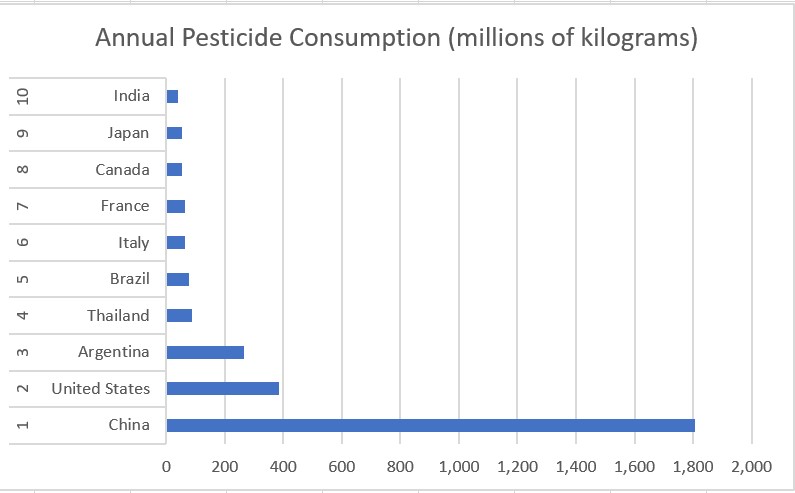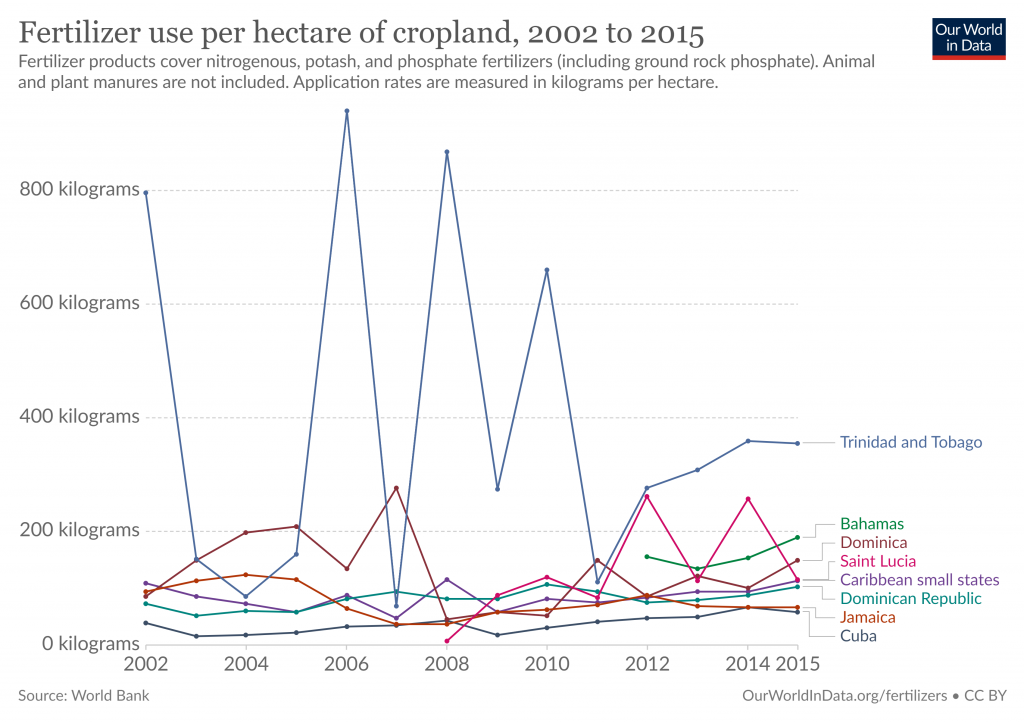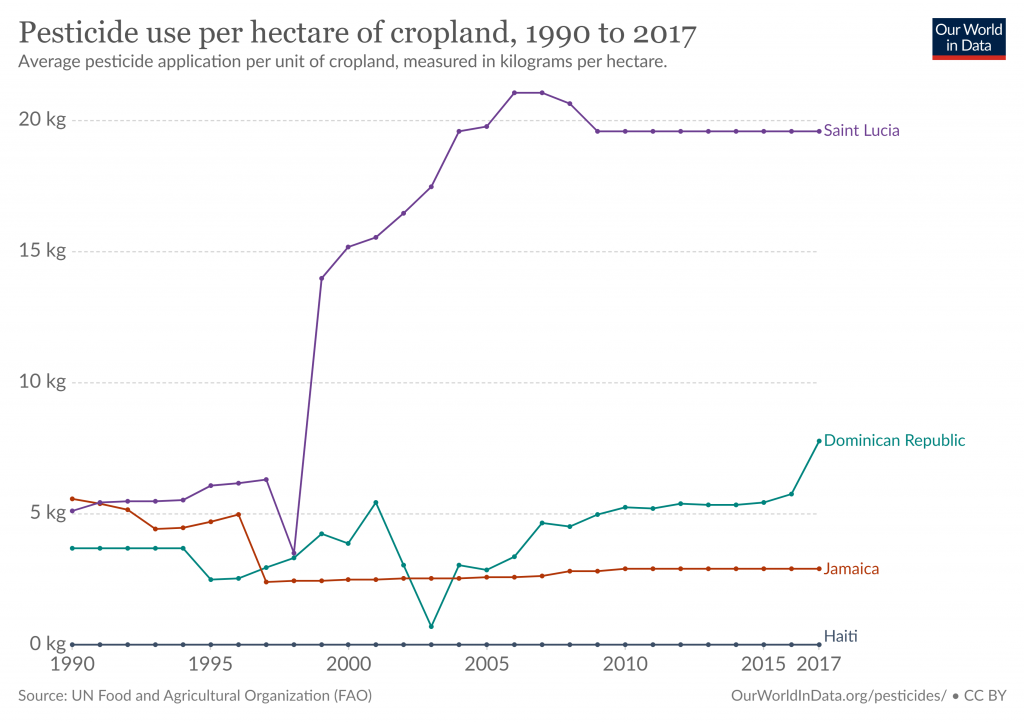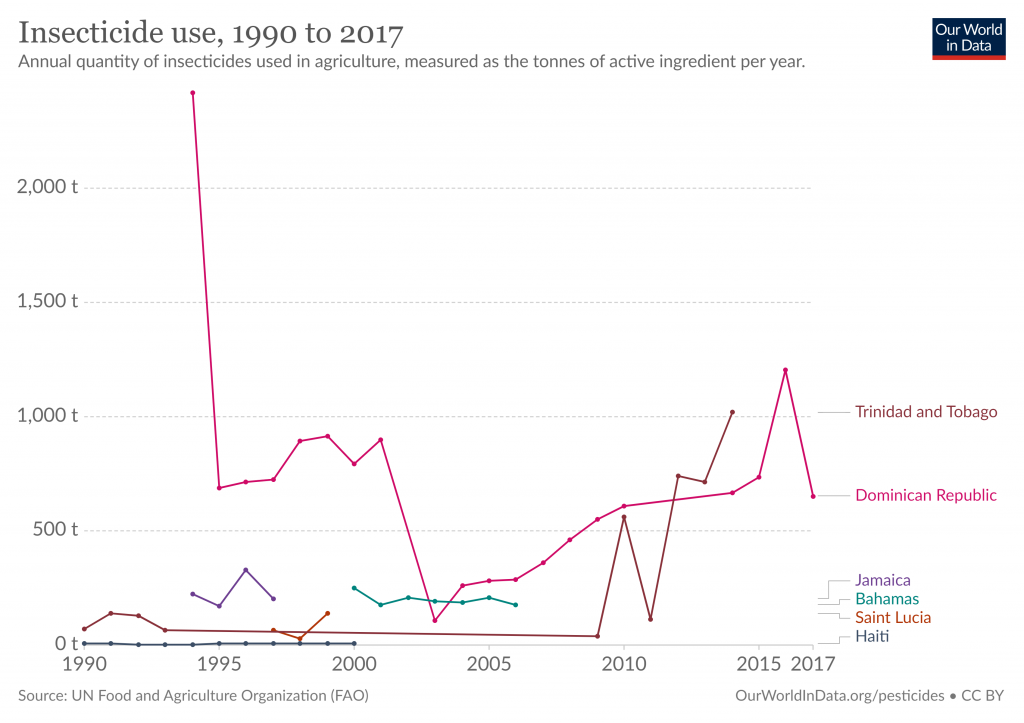Chemical uses (herbicides, pesticides & fertilizers) Hitchcock, in 1891, stated the cultivation of pine apple was a main crop on the islands but chiefly grown on Eleuthera. The red soil produced the finest fruit though the soil was, “strangely enough, wearing out.” It is here in his writing that we have our first evidence of a chemical fertilizer, imported from the United States, that allowed the land to yield large returns
According to a 2006 study, “GIWA Regional Assessment 3a for the Caribbean Small Island subsystem” , the impact of chemical pollution for the region was rated moderate. Several findings, as a result of the study included:
land clearance practices inefficient irrigation use of agrochemicals damage surface and groundwaters the use of low lying wetlands for rice cultivation requires heavy pesticide use; in St Kitts and Nevis water resources are susceptible to agricultural pollution due to its low lying position industrial pollution is particularly a problem in Trinidad and Tobago (sugar, rum, petrochemical, paint, agro-processing and metal). 2129430
#8221;{2129430:BMPQWVHP}#8221;,
chicago-author-date
50
13295
https://www.westindianboas.org/wp-content/plugins/zotpress/
%7B%22status%22%3A%22success%22%2C%22updateneeded%22%3Afalse%2C%22instance%22%3A%22zotpress-806323f4d8a278957b7b73d6fa5cce2d%22%2C%22meta%22%3A%7B%22request_last%22%3A2850%2C%22request_next%22%3A50%2C%22used_cache%22%3Atrue%7D%2C%22data%22%3A%5B%7B%22key%22%3A%22MSZZFLRI%22%2C%22library%22%3A%7B%22id%22%3A2129430%7D%2C%22meta%22%3A%7B%22creatorSummary%22%3A%22Emsley%22%2C%22parsedDate%22%3A%221977%22%2C%22numChildren%22%3A1%7D%2C%22bib%22%3A%22%3Cdiv%20class%3D%5C%22csl-bib-body%5C%22%20style%3D%5C%22line-height%3A%201.35%3B%20padding-left%3A%201em%3B%20text-indent%3A-1em%3B%5C%22%3E%5Cn%20%20%3Cdiv%20class%3D%5C%22csl-entry%5C%22%3EEmsley%2C%20Michael.%201977.%20%26%23x201C%3BSnakes%2C%20and%20Trinidad%20and%20Tobago.%26%23x201D%3B%20%3Ci%3EBulletin%20of%20the%20Maryland%20Herpetological%20Society%3C%5C%2Fi%3E%2013%20%284%29%3A%20201%26%23x2013%3B304.%3C%5C%2Fdiv%3E%5Cn%3C%5C%2Fdiv%3E%22%2C%22data%22%3A%7B%22itemType%22%3A%22journalArticle%22%2C%22title%22%3A%22Snakes%2C%20and%20Trinidad%20and%20Tobago%22%2C%22creators%22%3A%5B%7B%22creatorType%22%3A%22author%22%2C%22firstName%22%3A%22Michael%22%2C%22lastName%22%3A%22Emsley%22%7D%5D%2C%22abstractNote%22%3A%22%22%2C%22date%22%3A%221977%22%2C%22language%22%3A%22English%22%2C%22DOI%22%3A%22%22%2C%22ISSN%22%3A%22%22%2C%22url%22%3A%22%22%2C%22collections%22%3A%5B%224E2FHAKS%22%5D%2C%22dateModified%22%3A%222021-01-07T10%3A35%3A32Z%22%7D%7D%2C%7B%22key%22%3A%22RDAD448G%22%2C%22library%22%3A%7B%22id%22%3A2129430%7D%2C%22meta%22%3A%7B%22creatorSummary%22%3A%22Thomas%20and%20Benjamin%22%2C%22parsedDate%22%3A%222020-07-02%22%2C%22numChildren%22%3A1%7D%2C%22bib%22%3A%22%3Cdiv%20class%3D%5C%22csl-bib-body%5C%22%20style%3D%5C%22line-height%3A%201.35%3B%20padding-left%3A%201em%3B%20text-indent%3A-1em%3B%5C%22%3E%5Cn%20%20%3Cdiv%20class%3D%5C%22csl-entry%5C%22%3EThomas%2C%20Adelle%2C%20and%20Lisa%20Benjamin.%202020.%20%26%23x201C%3BNon-Economic%20Loss%20and%20Damage%3A%20Lessons%20from%20Displacement%20in%20the%20Caribbean.%26%23x201D%3B%20%3Ci%3EClimate%20Policy%3C%5C%2Fi%3E%2020%20%286%29%3A%20715%26%23x2013%3B28.%20%3Ca%20href%3D%27https%3A%5C%2F%5C%2Fdoi.org%5C%2F10.1080%5C%2F14693062.2019.1640105%27%3Ehttps%3A%5C%2F%5C%2Fdoi.org%5C%2F10.1080%5C%2F14693062.2019.1640105%3C%5C%2Fa%3E.%3C%5C%2Fdiv%3E%5Cn%3C%5C%2Fdiv%3E%22%2C%22data%22%3A%7B%22itemType%22%3A%22journalArticle%22%2C%22title%22%3A%22Non-economic%20loss%20and%20damage%3A%20lessons%20from%20displacement%20in%20the%20Caribbean%22%2C%22creators%22%3A%5B%7B%22creatorType%22%3A%22author%22%2C%22firstName%22%3A%22Adelle%22%2C%22lastName%22%3A%22Thomas%22%7D%2C%7B%22creatorType%22%3A%22author%22%2C%22firstName%22%3A%22Lisa%22%2C%22lastName%22%3A%22Benjamin%22%7D%5D%2C%22abstractNote%22%3A%22Climate-induced%20displacement%20has%20direct%20implications%20for%20non-economic%20loss%20and%20damage%2C%20including%20threats%20to%20health%20and%20wellbeing%20and%20loss%20of%20culture%20and%20agency.%20Displacement%20due%20to%20extreme%20events%20is%20particularly%20challenging%20for%20small%20island%20developing%20states%20%28SIDS%29%20given%20their%20high%20exposure%20and%20vulnerability%20to%20tropical%20cyclones.%20Devastating%20hurricanes%20in%20the%20Caribbean%20in%202017%20exposed%20non-economic%20loss%20and%20damage%20associated%20with%20prolonged%20displacement%20of%20entire%20island%20populations%20due%20to%20complete%20destruction%20of%20communities.%20Such%20was%20the%20case%20in%20Ragged%20Island%2C%20The%20Bahamas%2C%20where%20the%20entire%20population%20was%20displaced.%20This%20study%20assesses%20national%20policies%2C%20plans%2C%20legislation%20and%20reports%20from%20The%20Bahamas%20to%20determine%20non-economic%20loss%20and%20damage%20experienced%20by%20displaced%20residents%20and%20how%20the%20policy%20landscape%20addresses%20these%20issues.%20We%20%5Cufb01nd%20that%20non-economic%20loss%20and%20damage%20was%20acknowledged%20neither%20by%20the%20policy%20landscape%20nor%20by%20Government%20actions%2C%20but%20that%20there%20were%20likely%20health%20impacts%20and%20disruptions%20to%20sense%20of%20place%20and%20connection%20to%20the%20island.%20Failure%20to%20consider%20non-economic%20loss%20and%20damage%20also%20contributed%20to%20assessments%20that%20costs%20of%20rebuilding%20outweighed%20bene%5Cufb01ts.%20While%20existing%20literature%20has%20acknowledged%20policy%20de%5Cufb01ciencies%20on%20loss%20and%20damage%20at%20the%20national%20level%20in%20SIDS%2C%20this%20study%20illustrates%20real-world%20impacts%20of%20these%20de%5Cufb01ciencies.%20The%20case%20of%20Ragged%20Island%20highlights%20the%20need%20for%20SIDS%20to%20take%20the%20lead%20in%20developing%20national%20responses%20to%20loss%20and%20damage%20as%20they%20are%20currently%20experiencing%20severe%20impacts%2C%20which%20are%20intensi%5Cufb01ed%20by%20the%20lack%20of%20clear%20policies%2C%20plans%20or%20strategies.%22%2C%22date%22%3A%222020-07-02%22%2C%22language%22%3A%22en%22%2C%22DOI%22%3A%2210.1080%5C%2F14693062.2019.1640105%22%2C%22ISSN%22%3A%221469-3062%2C%201752-7457%22%2C%22url%22%3A%22https%3A%5C%2F%5C%2Fwww.tandfonline.com%5C%2Fdoi%5C%2Ffull%5C%2F10.1080%5C%2F14693062.2019.1640105%22%2C%22collections%22%3A%5B%224E2FHAKS%22%5D%2C%22dateModified%22%3A%222021-01-06T18%3A53%3A52Z%22%7D%7D%2C%7B%22key%22%3A%22P8IFV9ML%22%2C%22library%22%3A%7B%22id%22%3A2129430%7D%2C%22meta%22%3A%7B%22creatorSummary%22%3A%22Riley%20and%20Walters%22%2C%22parsedDate%22%3A%221980%22%2C%22numChildren%22%3A1%7D%2C%22bib%22%3A%22%3Cdiv%20class%3D%5C%22csl-bib-body%5C%22%20style%3D%5C%22line-height%3A%201.35%3B%20padding-left%3A%201em%3B%20text-indent%3A-1em%3B%5C%22%3E%5Cn%20%20%3Cdiv%20class%3D%5C%22csl-entry%5C%22%3ERiley%2C%20J.%2C%20and%20L.%20S.%20Walters.%201980.%20%26%23x201C%3BPorocephalus%20Dominicana%20n.Sp.%20from%20the%20Dominican%20Boa%20%28Constrictor%20Constrictor%20Nebulosus%29.%26%23x201D%3B%20%3Ci%3ESystematic%20Parasitology%3C%5C%2Fi%3E%201%20%282%29%3A%20123%26%23x2013%3B26.%20%3Ca%20href%3D%27https%3A%5C%2F%5C%2Fdoi.org%5C%2F10.1007%5C%2FBF00009858%27%3Ehttps%3A%5C%2F%5C%2Fdoi.org%5C%2F10.1007%5C%2FBF00009858%3C%5C%2Fa%3E.%3C%5C%2Fdiv%3E%5Cn%3C%5C%2Fdiv%3E%22%2C%22data%22%3A%7B%22itemType%22%3A%22journalArticle%22%2C%22title%22%3A%22Porocephalus%20dominicana%20n.sp.%20from%20the%20Dominican%20boa%20%28Constrictor%20constrictor%20nebulosus%29%22%2C%22creators%22%3A%5B%7B%22creatorType%22%3A%22author%22%2C%22firstName%22%3A%22J.%22%2C%22lastName%22%3A%22Riley%22%7D%2C%7B%22creatorType%22%3A%22author%22%2C%22firstName%22%3A%22L.%20S.%22%2C%22lastName%22%3A%22Walters%22%7D%5D%2C%22abstractNote%22%3A%22%22%2C%22date%22%3A%221%5C%2F1980%22%2C%22language%22%3A%22en%22%2C%22DOI%22%3A%2210.1007%5C%2FBF00009858%22%2C%22ISSN%22%3A%220165-5752%2C%201573-5192%22%2C%22url%22%3A%22http%3A%5C%2F%5C%2Flink.springer.com%5C%2F10.1007%5C%2FBF00009858%22%2C%22collections%22%3A%5B%224E2FHAKS%22%5D%2C%22dateModified%22%3A%222021-01-06T00%3A00%3A10Z%22%7D%7D%2C%7B%22key%22%3A%22L5ATU9XP%22%2C%22library%22%3A%7B%22id%22%3A2129430%7D%2C%22meta%22%3A%7B%22creatorSummary%22%3A%22MacNames%20et%20al.%22%2C%22parsedDate%22%3A%222013%22%2C%22numChildren%22%3A1%7D%2C%22bib%22%3A%22%3Cdiv%20class%3D%5C%22csl-bib-body%5C%22%20style%3D%5C%22line-height%3A%201.35%3B%20padding-left%3A%201em%3B%20text-indent%3A-1em%3B%5C%22%3E%5Cn%20%20%3Cdiv%20class%3D%5C%22csl-entry%5C%22%3EMacNames%2C%20Ross%2C%20Molly%20Oden%2C%20Sierra%20Padilla%2C%20and%20Matt%20Stankey.%202013.%20%26%23x201C%3BMorphological%20Differences%20between%20Three%20Common%20Dominican%20Snake%20Species.%26%23x201D%3B%20Tropical%20and%20Field%20Biology%2C%20Dominica.%3C%5C%2Fdiv%3E%5Cn%3C%5C%2Fdiv%3E%22%2C%22data%22%3A%7B%22itemType%22%3A%22thesis%22%2C%22title%22%3A%22Morphological%20differences%20between%20three%20common%20Dominican%20snake%20species%22%2C%22creators%22%3A%5B%7B%22creatorType%22%3A%22author%22%2C%22firstName%22%3A%22Ross%22%2C%22lastName%22%3A%22MacNames%22%7D%2C%7B%22creatorType%22%3A%22author%22%2C%22firstName%22%3A%22Molly%22%2C%22lastName%22%3A%22Oden%22%7D%2C%7B%22creatorType%22%3A%22author%22%2C%22firstName%22%3A%22Sierra%22%2C%22lastName%22%3A%22Padilla%22%7D%2C%7B%22creatorType%22%3A%22author%22%2C%22firstName%22%3A%22Matt%22%2C%22lastName%22%3A%22Stankey%22%7D%5D%2C%22abstractNote%22%3A%22The%20island%20of%20Dominica%20is%20home%20to%20a%20wide%20array%20of%20herptofauna%20including%20four%20snake%20species.%20Of%20these%2C%20only%20Boa%20nebulosa%2C%20Liophis%20juliae%20juliae%2C%20and%20Alsophis%20antillensis%20were%20included%20in%20the%20study.%20We%20captured%2C%20measured%2C%20and%20photographed%20a%20total%20of%2016%20snakes%20in%20order%20to%20compare%20morphological%20differences%20between%20the%20species.%20Our%20results%20indicate%20that%20there%20are%20indeed%20significant%20morphological%20differences%20between%20the%20three%20species%2C%20specifically%20in%20regards%20to%20A.%20antillensis%2C%20which%20possesses%20a%20proportionally%20smaller%20and%20narrower%20head%20than%20either%20L.%20juliae%20juliae%20or%20B.%20nebulosa.%20Additionally%2C%20a%20great%20deal%20of%20intraspecies%20variation%20in%20coloring%20and%20patterning%20exists%2C%20specifically%20among%20A.antillensis%20and%20L.%20juliae%20juliae.%22%2C%22thesisType%22%3A%22Tropical%20and%20Field%20Biology%22%2C%22university%22%3A%22%22%2C%22date%22%3A%222013%22%2C%22language%22%3A%22en%22%2C%22url%22%3A%22%22%2C%22collections%22%3A%5B%224E2FHAKS%22%5D%2C%22dateModified%22%3A%222021-01-06T00%3A00%3A05Z%22%7D%7D%2C%7B%22key%22%3A%22W65LY3HC%22%2C%22library%22%3A%7B%22id%22%3A2129430%7D%2C%22meta%22%3A%7B%22creatorSummary%22%3A%22L%5Cu00e9ger%20et%20al.%22%2C%22parsedDate%22%3A%222013%22%2C%22numChildren%22%3A1%7D%2C%22bib%22%3A%22%3Cdiv%20class%3D%5C%22csl-bib-body%5C%22%20style%3D%5C%22line-height%3A%201.35%3B%20padding-left%3A%201em%3B%20text-indent%3A-1em%3B%5C%22%3E%5Cn%20%20%3Cdiv%20class%3D%5C%22csl-entry%5C%22%3EL%26%23xE9%3Bger%2C%20Elsa%2C%20Gwena%26%23xEB%3Bl%20Vourc%26%23x2019%3Bh%2C%20Laurence%20Vial%2C%20Christine%20Chevillon%2C%20and%20Karen%20D.%20McCoy.%202013.%20%26%23x201C%3BChanging%20Distributions%20of%20Ticks%3A%20Causes%20and%20Consequences.%26%23x201D%3B%20%3Ci%3EExperimental%20and%20Applied%20Acarology%3C%5C%2Fi%3E%2059%20%281%26%23x2013%3B2%29%3A%20219%26%23x2013%3B44.%20%3Ca%20href%3D%27https%3A%5C%2F%5C%2Fdoi.org%5C%2F10.1007%5C%2Fs10493-012-9615-0%27%3Ehttps%3A%5C%2F%5C%2Fdoi.org%5C%2F10.1007%5C%2Fs10493-012-9615-0%3C%5C%2Fa%3E.%3C%5C%2Fdiv%3E%5Cn%3C%5C%2Fdiv%3E%22%2C%22data%22%3A%7B%22itemType%22%3A%22journalArticle%22%2C%22title%22%3A%22Changing%20distributions%20of%20ticks%3A%20causes%20and%20consequences%22%2C%22creators%22%3A%5B%7B%22creatorType%22%3A%22author%22%2C%22firstName%22%3A%22Elsa%22%2C%22lastName%22%3A%22L%5Cu00e9ger%22%7D%2C%7B%22creatorType%22%3A%22author%22%2C%22firstName%22%3A%22Gwena%5Cu00ebl%22%2C%22lastName%22%3A%22Vourc%5Cu2019h%22%7D%2C%7B%22creatorType%22%3A%22author%22%2C%22firstName%22%3A%22Laurence%22%2C%22lastName%22%3A%22Vial%22%7D%2C%7B%22creatorType%22%3A%22author%22%2C%22firstName%22%3A%22Christine%22%2C%22lastName%22%3A%22Chevillon%22%7D%2C%7B%22creatorType%22%3A%22author%22%2C%22firstName%22%3A%22Karen%20D.%22%2C%22lastName%22%3A%22McCoy%22%7D%5D%2C%22abstractNote%22%3A%22Today%2C%20we%20are%20witnessing%20changes%20in%20the%20spatial%20distribution%20and%20abundance%20of%20many%20species%2C%20including%20ticks%20and%20their%20associated%20pathogens.%20Evidence%20that%20these%20changes%20are%20primarily%20due%20to%20climate%20change%2C%20habitat%20modi%5Cufb01cations%2C%20and%20the%20globalisation%20of%20human%20activities%20are%20accumulating.%20Changes%20in%20the%20distribution%20of%20ticks%20and%20their%20invasion%20into%20new%20regions%20can%20have%20numerous%20consequences%20including%20modi%5Cufb01cations%20in%20their%20ecological%20characteristics%20and%20those%20of%20endemic%20species%2C%20impacts%20on%20the%20dynamics%20of%20local%20host%20populations%20and%20the%20emergence%20of%20human%20and%20livestock%20disease.%20Here%2C%20we%20review%20the%20principal%20causes%20for%20distributional%20shifts%20in%20tick%20populations%20and%20their%20consequences%20in%20terms%20of%20the%20ecological%20attributes%20of%20the%20species%20in%20question%20%28i.e.%20phenotypic%20and%20genetic%20responses%29%2C%20pathogen%20transmission%20and%20disease%20epidemiology.%20We%20also%20describe%20different%20methodological%20approaches%20currently%20used%20to%20assess%20and%20predict%20such%20changes%20and%20their%20consequences.%20We%20%5Cufb01nish%20with%20a%20discussion%20of%20new%20research%20avenues%20to%20develop%20in%20order%20to%20improve%20our%20understanding%20of%20these%20host%5Cu2013vector%5Cu2013pathogen%20interactions%20in%20the%20context%20of%20a%20changing%20world.%22%2C%22date%22%3A%222%5C%2F2013%22%2C%22language%22%3A%22en%22%2C%22DOI%22%3A%2210.1007%5C%2Fs10493-012-9615-0%22%2C%22ISSN%22%3A%220168-8162%2C%201572-9702%22%2C%22url%22%3A%22http%3A%5C%2F%5C%2Flink.springer.com%5C%2F10.1007%5C%2Fs10493-012-9615-0%22%2C%22collections%22%3A%5B%224E2FHAKS%22%5D%2C%22dateModified%22%3A%222021-01-06T00%3A00%3A00Z%22%7D%7D%2C%7B%22key%22%3A%22XMJHLQJU%22%2C%22library%22%3A%7B%22id%22%3A2129430%7D%2C%22meta%22%3A%7B%22creatorSummary%22%3A%22Crews%22%2C%22parsedDate%22%3A%222013%22%2C%22numChildren%22%3A1%7D%2C%22bib%22%3A%22%3Cdiv%20class%3D%5C%22csl-bib-body%5C%22%20style%3D%5C%22line-height%3A%201.35%3B%20padding-left%3A%201em%3B%20text-indent%3A-1em%3B%5C%22%3E%5Cn%20%20%3Cdiv%20class%3D%5C%22csl-entry%5C%22%3ECrews%2C%20Emily.%202013.%20%26%23x201C%3BSurvey%20of%20Ticks%20on%20Reptilian%20Hosts%20on%20the%20Island%20of%20Dominica%2C%20West%20Indies%20Study%20Abroad%20Dominica.%26%23x201D%3B%20Study%20Abroad%20Dominica%3A%20Texas%20A%26amp%3BM%20University.%3C%5C%2Fdiv%3E%5Cn%3C%5C%2Fdiv%3E%22%2C%22data%22%3A%7B%22itemType%22%3A%22thesis%22%2C%22title%22%3A%22Survey%20of%20Ticks%20on%20Reptilian%20Hosts%20on%20the%20Island%20of%20Dominica%2C%20West%20Indies%20Study%20Abroad%20Dominica%22%2C%22creators%22%3A%5B%7B%22creatorType%22%3A%22author%22%2C%22firstName%22%3A%22Emily%22%2C%22lastName%22%3A%22Crews%22%7D%5D%2C%22abstractNote%22%3A%22%22%2C%22thesisType%22%3A%22%22%2C%22university%22%3A%22Texas%20A%26M%20University%22%2C%22date%22%3A%222013%22%2C%22language%22%3A%22en%22%2C%22url%22%3A%22%22%2C%22collections%22%3A%5B%224E2FHAKS%22%5D%2C%22dateModified%22%3A%222021-01-05T23%3A04%3A01Z%22%7D%7D%2C%7B%22key%22%3A%227VG5BKDQ%22%2C%22library%22%3A%7B%22id%22%3A2129430%7D%2C%22meta%22%3A%7B%22creatorSummary%22%3A%22Castro-Herrera%20et%20al.%22%2C%22parsedDate%22%3A%222007%22%2C%22numChildren%22%3A1%7D%2C%22bib%22%3A%22%3Cdiv%20class%3D%5C%22csl-bib-body%5C%22%20style%3D%5C%22line-height%3A%201.35%3B%20padding-left%3A%201em%3B%20text-indent%3A-1em%3B%5C%22%3E%5Cn%20%20%3Cdiv%20class%3D%5C%22csl-entry%5C%22%3ECastro-Herrera%2C%20Fernando%2C%20Wilmar%20Bol%26%23xED%3Bvar-Garc%26%23xED%3Ba%2C%20and%20Mar%26%23xED%3Ba%20Isabel%20Herrera-Montes.%202007.%20%3Ci%3EGU%26%23xCD%3BA%20DE%20LOS%20ANFIBIOS%20Y%20REPTILES%20DEL%20BOSQUE%20DE%20YOTOCO%2C%20VALLE%20DEL%20CAUCA%20-%20COLOMBIA%3C%5C%2Fi%3E.%20CALI%2C%20V.%20COLOMBIA%3A%20LABORATORIO%20DE%20HERPETOLOG%26%23xCD%3BA%20DEPARTAMENTO%20DE%20BIOLOG%26%23xCD%3BA%20UNIVERSIDAD%20DEL%20VALLE.%3C%5C%2Fdiv%3E%5Cn%3C%5C%2Fdiv%3E%22%2C%22data%22%3A%7B%22itemType%22%3A%22book%22%2C%22title%22%3A%22GU%5Cu00cdA%20DE%20LOS%20ANFIBIOS%20Y%20REPTILES%20DEL%20BOSQUE%20DE%20YOTOCO%2C%20VALLE%20DEL%20CAUCA%20-%20COLOMBIA%22%2C%22creators%22%3A%5B%7B%22creatorType%22%3A%22author%22%2C%22firstName%22%3A%22Fernando%22%2C%22lastName%22%3A%22Castro-Herrera%22%7D%2C%7B%22creatorType%22%3A%22author%22%2C%22firstName%22%3A%22Wilmar%22%2C%22lastName%22%3A%22Bol%5Cu00edvar-Garc%5Cu00eda%22%7D%2C%7B%22creatorType%22%3A%22author%22%2C%22firstName%22%3A%22Mar%5Cu00eda%20Isabel%22%2C%22lastName%22%3A%22Herrera-Montes%22%7D%5D%2C%22abstractNote%22%3A%22%22%2C%22date%22%3A%222007%22%2C%22language%22%3A%22es%22%2C%22ISBN%22%3A%22%22%2C%22url%22%3A%22%22%2C%22collections%22%3A%5B%224E2FHAKS%22%5D%2C%22dateModified%22%3A%222021-01-05T22%3A45%3A31Z%22%7D%7D%2C%7B%22key%22%3A%22S3KBSPQ4%22%2C%22library%22%3A%7B%22id%22%3A2129430%7D%2C%22meta%22%3A%7B%22creatorSummary%22%3A%22Whyte%22%2C%22parsedDate%22%3A%222002%22%2C%22numChildren%22%3A1%7D%2C%22bib%22%3A%22%3Cdiv%20class%3D%5C%22csl-bib-body%5C%22%20style%3D%5C%22line-height%3A%201.35%3B%20padding-left%3A%201em%3B%20text-indent%3A-1em%3B%5C%22%3E%5Cn%20%20%3Cdiv%20class%3D%5C%22csl-entry%5C%22%3EWhyte%2C%20Ian.%202002.%20%3Ci%3ELandscape%20and%20History%20since%201500%3C%5C%2Fi%3E.%20Globalities.%20London%3A%20Reaktion%20Books.%3C%5C%2Fdiv%3E%5Cn%3C%5C%2Fdiv%3E%22%2C%22data%22%3A%7B%22itemType%22%3A%22book%22%2C%22title%22%3A%22Landscape%20and%20history%20since%201500%22%2C%22creators%22%3A%5B%7B%22creatorType%22%3A%22author%22%2C%22firstName%22%3A%22Ian%22%2C%22lastName%22%3A%22Whyte%22%7D%5D%2C%22abstractNote%22%3A%22%22%2C%22date%22%3A%222002%22%2C%22language%22%3A%22eng%22%2C%22ISBN%22%3A%22978-1-86189-138-9%22%2C%22url%22%3A%22%22%2C%22collections%22%3A%5B%224E2FHAKS%22%5D%2C%22dateModified%22%3A%222021-01-05T22%3A45%3A31Z%22%7D%7D%2C%7B%22key%22%3A%22APT7GYYN%22%2C%22library%22%3A%7B%22id%22%3A2129430%7D%2C%22meta%22%3A%7B%22creatorSummary%22%3A%22Boulenger%22%2C%22parsedDate%22%3A%221896%22%2C%22numChildren%22%3A1%7D%2C%22bib%22%3A%22%3Cdiv%20class%3D%5C%22csl-bib-body%5C%22%20style%3D%5C%22line-height%3A%201.35%3B%20padding-left%3A%201em%3B%20text-indent%3A-1em%3B%5C%22%3E%5Cn%20%20%3Cdiv%20class%3D%5C%22csl-entry%5C%22%3EBoulenger%2C%20G.%20A.%201896.%20%26%23x201C%3BUeber%20Einige%20Reptilien%20von%20Der%20Insel%20Mona%20%28Westindien%29.%26%23x201D%3B%20%3Ci%3EJahresbericht%20Und%20Abhandlungen%20Des%20Naturwissenschaftlichen%20Vereins%20in%20Magdeburg%3C%5C%2Fi%3E%2C%206.%3C%5C%2Fdiv%3E%5Cn%3C%5C%2Fdiv%3E%22%2C%22data%22%3A%7B%22itemType%22%3A%22journalArticle%22%2C%22title%22%3A%22Ueber%20einige%20Reptilien%20von%20der%20Insel%20Mona%20%28Westindien%29%22%2C%22creators%22%3A%5B%7B%22creatorType%22%3A%22author%22%2C%22firstName%22%3A%22G.%20A.%22%2C%22lastName%22%3A%22Boulenger%22%7D%5D%2C%22abstractNote%22%3A%22%22%2C%22date%22%3A%221896%22%2C%22language%22%3A%22en%22%2C%22DOI%22%3A%22%22%2C%22ISSN%22%3A%22%22%2C%22url%22%3A%22%22%2C%22collections%22%3A%5B%224E2FHAKS%22%5D%2C%22dateModified%22%3A%222021-01-05T20%3A38%3A36Z%22%7D%7D%2C%7B%22key%22%3A%225AY8W5RK%22%2C%22library%22%3A%7B%22id%22%3A2129430%7D%2C%22meta%22%3A%7B%22creatorSummary%22%3A%22Williams%22%2C%22parsedDate%22%3A%221918%22%2C%22numChildren%22%3A0%7D%2C%22bib%22%3A%22%3Cdiv%20class%3D%5C%22csl-bib-body%5C%22%20style%3D%5C%22line-height%3A%201.35%3B%20padding-left%3A%201em%3B%20text-indent%3A-1em%3B%5C%22%3E%5Cn%20%20%3Cdiv%20class%3D%5C%22csl-entry%5C%22%3EWilliams%2C%20C.B.%201918.%20%26%23x201C%3BThe%20Food%20Habits%20of%20the%20Mongoose%20in%20Trinidad.%26%23x201D%3B%20%3Ci%3EBulletin%20of%20the%20Department%20of%20Agriculture%2C%20Trinidad%20and%20Tobago.%3C%5C%2Fi%3E%2017%3A%20167%26%23x2013%3B86.%20%3Ca%20href%3D%27https%3A%5C%2F%5C%2Fwww.biodiversitylibrary.org%5C%2Fitem%5C%2F27225%27%3Ehttps%3A%5C%2F%5C%2Fwww.biodiversitylibrary.org%5C%2Fitem%5C%2F27225%3C%5C%2Fa%3E.%3C%5C%2Fdiv%3E%5Cn%3C%5C%2Fdiv%3E%22%2C%22data%22%3A%7B%22itemType%22%3A%22journalArticle%22%2C%22title%22%3A%22The%20food%20habits%20of%20the%20mongoose%20in%20Trinidad%22%2C%22creators%22%3A%5B%7B%22creatorType%22%3A%22author%22%2C%22firstName%22%3A%22C.B.%22%2C%22lastName%22%3A%22Williams%22%7D%5D%2C%22abstractNote%22%3A%22%22%2C%22date%22%3A%221918%22%2C%22language%22%3A%22%22%2C%22DOI%22%3A%22%22%2C%22ISSN%22%3A%22%22%2C%22url%22%3A%22https%3A%5C%2F%5C%2Fwww.biodiversitylibrary.org%5C%2Fitem%5C%2F27225%22%2C%22collections%22%3A%5B%224E2FHAKS%22%5D%2C%22dateModified%22%3A%222021-01-05T20%3A31%3A08Z%22%7D%7D%2C%7B%22key%22%3A%22AZVW2LR9%22%2C%22library%22%3A%7B%22id%22%3A2129430%7D%2C%22meta%22%3A%7B%22creatorSummary%22%3A%22Hayward%20et%20al.%22%2C%22parsedDate%22%3A%222009%22%2C%22numChildren%22%3A0%7D%2C%22bib%22%3A%22%3Cdiv%20class%3D%5C%22csl-bib-body%5C%22%20style%3D%5C%22line-height%3A%201.35%3B%20padding-left%3A%201em%3B%20text-indent%3A-1em%3B%5C%22%3E%5Cn%20%20%3Cdiv%20class%3D%5C%22csl-entry%5C%22%3EHayward%2C%20Michele%20H.%2C%20Lesley-Gail%20Atkinson%2C%20and%20Michael%20A.%20Cinquino%2C%20eds.%202009.%20%3Ci%3ERock%20Art%20of%20the%20Caribbean%3C%5C%2Fi%3E.%20Caribbean%20Archaeology%20and%20Ethnohistory.%20Tuscaloosa%3A%20University%20of%20Alabama%20Press.%3C%5C%2Fdiv%3E%5Cn%3C%5C%2Fdiv%3E%22%2C%22data%22%3A%7B%22itemType%22%3A%22book%22%2C%22title%22%3A%22Rock%20art%20of%20the%20Caribbean%22%2C%22creators%22%3A%5B%7B%22creatorType%22%3A%22editor%22%2C%22firstName%22%3A%22Michele%20H.%22%2C%22lastName%22%3A%22Hayward%22%7D%2C%7B%22creatorType%22%3A%22editor%22%2C%22firstName%22%3A%22Lesley-Gail%22%2C%22lastName%22%3A%22Atkinson%22%7D%2C%7B%22creatorType%22%3A%22editor%22%2C%22firstName%22%3A%22Michael%20A.%22%2C%22lastName%22%3A%22Cinquino%22%7D%5D%2C%22abstractNote%22%3A%22%22%2C%22date%22%3A%222009%22%2C%22language%22%3A%22%22%2C%22ISBN%22%3A%22978-0-8173-1650-1%20978-0-8173-5530-2%20978-0-8173-8159-2%22%2C%22url%22%3A%22%22%2C%22collections%22%3A%5B%224E2FHAKS%22%5D%2C%22dateModified%22%3A%222021-01-05T14%3A20%3A31Z%22%7D%7D%2C%7B%22key%22%3A%22XTHVM2RW%22%2C%22library%22%3A%7B%22id%22%3A2129430%7D%2C%22meta%22%3A%7B%22creatorSummary%22%3A%22Societ%5Cu00e0%20dei%20naturalisti%20e%20matematici%20di%20Modena.%22%2C%22parsedDate%22%3A%221885%22%2C%22numChildren%22%3A0%7D%2C%22bib%22%3A%22%3Cdiv%20class%3D%5C%22csl-bib-body%5C%22%20style%3D%5C%22line-height%3A%201.35%3B%20padding-left%3A%201em%3B%20text-indent%3A-1em%3B%5C%22%3E%5Cn%20%20%3Cdiv%20class%3D%5C%22csl-entry%5C%22%3ESociet%26%23xE0%3B%20dei%20naturalisti%20e%20matematici%20di%20Modena.%201885.%20%3Ci%3EAtti%20Della%20Societ%26%23xE0%3B%20Dei%20Naturalisti%20e%20Matematici%20Di%20Modena.%20Memorie%3C%5C%2Fi%3E.%20Vol.%204.%203.%20Modena%3A%20Societ%26%23xE0%3B%20Tipografica%20Editrice%20Modenese%20-%20Mucchi.%20%3Ca%20href%3D%27https%3A%5C%2F%5C%2Fwww.biodiversitylibrary.org%5C%2Fitem%5C%2F96100%27%3Ehttps%3A%5C%2F%5C%2Fwww.biodiversitylibrary.org%5C%2Fitem%5C%2F96100%3C%5C%2Fa%3E.%3C%5C%2Fdiv%3E%5Cn%3C%5C%2Fdiv%3E%22%2C%22data%22%3A%7B%22itemType%22%3A%22book%22%2C%22title%22%3A%22Atti%20della%20Societ%5Cu00e0%20dei%20naturalisti%20e%20matematici%20di%20Modena.%20Memorie%22%2C%22creators%22%3A%5B%7B%22creatorType%22%3A%22author%22%2C%22name%22%3A%22Societ%5Cu00e0%20dei%20naturalisti%20e%20matematici%20di%20Modena.%22%7D%5D%2C%22abstractNote%22%3A%22%22%2C%22date%22%3A%221885%22%2C%22language%22%3A%22%22%2C%22ISBN%22%3A%22%22%2C%22url%22%3A%22https%3A%5C%2F%5C%2Fwww.biodiversitylibrary.org%5C%2Fitem%5C%2F96100%22%2C%22collections%22%3A%5B%224E2FHAKS%22%5D%2C%22dateModified%22%3A%222021-01-04T15%3A58%3A33Z%22%7D%7D%2C%7B%22key%22%3A%224RJDIP8U%22%2C%22library%22%3A%7B%22id%22%3A2129430%7D%2C%22meta%22%3A%7B%22creatorSummary%22%3A%22Shaw%20et%20al.%22%2C%22parsedDate%22%3A%221802%22%2C%22numChildren%22%3A2%7D%2C%22bib%22%3A%22%3Cdiv%20class%3D%5C%22csl-bib-body%5C%22%20style%3D%5C%22line-height%3A%201.35%3B%20padding-left%3A%201em%3B%20text-indent%3A-1em%3B%5C%22%3E%5Cn%20%20%3Cdiv%20class%3D%5C%22csl-entry%5C%22%3EShaw%2C%20George%2C%20Mrs.%20Griffith%2C%20Charles%20Heath%2C%20and%20James%20Francis%20Stephens.%201802.%20%3Ci%3EGeneral%20Zoology%2C%20or%20Systematic%20Natural%20History%3C%5C%2Fi%3E.%20Vol.%20v.3%3Apt.1-2%20%281802%29.%20London%2C%3A%20Printed%20for%20G.%20Kearsley%2C.%20%3Ca%20href%3D%27https%3A%5C%2F%5C%2Fwww.biodiversitylibrary.org%5C%2Fitem%5C%2F175491%27%3Ehttps%3A%5C%2F%5C%2Fwww.biodiversitylibrary.org%5C%2Fitem%5C%2F175491%3C%5C%2Fa%3E.%3C%5C%2Fdiv%3E%5Cn%3C%5C%2Fdiv%3E%22%2C%22data%22%3A%7B%22itemType%22%3A%22book%22%2C%22title%22%3A%22General%20zoology%2C%20or%20Systematic%20natural%20history%22%2C%22creators%22%3A%5B%7B%22creatorType%22%3A%22author%22%2C%22firstName%22%3A%22George%22%2C%22lastName%22%3A%22Shaw%22%7D%2C%7B%22creatorType%22%3A%22author%22%2C%22firstName%22%3A%22Mrs.%2C%22%2C%22lastName%22%3A%22Griffith%22%7D%2C%7B%22creatorType%22%3A%22author%22%2C%22firstName%22%3A%22Charles%2C%22%2C%22lastName%22%3A%22Heath%22%7D%2C%7B%22creatorType%22%3A%22author%22%2C%22firstName%22%3A%22James%20Francis%2C%22%2C%22lastName%22%3A%22Stephens%22%7D%5D%2C%22abstractNote%22%3A%22%22%2C%22date%22%3A%221802%22%2C%22language%22%3A%22%22%2C%22ISBN%22%3A%22%22%2C%22url%22%3A%22https%3A%5C%2F%5C%2Fwww.biodiversitylibrary.org%5C%2Fitem%5C%2F175491%22%2C%22collections%22%3A%5B%224E2FHAKS%22%5D%2C%22dateModified%22%3A%222021-01-04T14%3A54%3A10Z%22%7D%7D%2C%7B%22key%22%3A%22C8JXG7PQ%22%2C%22library%22%3A%7B%22id%22%3A2129430%7D%2C%22meta%22%3A%7B%22creatorSummary%22%3A%22Chenu%20et%20al.%22%2C%22parsedDate%22%3A%221880%22%2C%22numChildren%22%3A1%7D%2C%22bib%22%3A%22%3Cdiv%20class%3D%5C%22csl-bib-body%5C%22%20style%3D%5C%22line-height%3A%201.35%3B%20padding-left%3A%201em%3B%20text-indent%3A-1em%3B%5C%22%3E%5Cn%20%20%3Cdiv%20class%3D%5C%22csl-entry%5C%22%3EChenu%2C%20Jean-Charles%2C%20Marc%20Athanase%20Parfait%20%26%23x152%3Billet%20Des%20Murs%2C%20E.%20Desmarest%2C%20Eug%26%23xE8%3Bne%20Desmarest%2C%20and%20Aristide%20Dupuis.%201880.%20%3Ci%3EEncyclop%26%23xE9%3Bdie%20d%26%23x2019%3Bhistoire%20Naturelle%3B%20Ou%2C%20Trait%26%23xE9%3B%20Complet%20de%20Cette%20Science%20d%26%23x2019%3Bapr%26%23xE8%3Bs%20Les%20Travaux%20Des%20Naturalistes%20Les%20plus%20%26%23xC9%3Bminents%20de%20Tous%20Les%20Pays%20et%20de%20Toutes%20Les%20%26%23xC9%3Bpoques%3A%20Buffon%2C%20Daubenton%2C%20Lac%26%23xE9%3Bp%26%23xE8%3Bde%2C%20G.%20Cuvier%2C%20F.%20Cuvier%2C%20Geoffroy%20Saint-Hilaire%2C%20Latreille%2C%20De%20Jussieu%2C%20Brongniart%2C%20Etc.%3C%5C%2Fi%3E%20Vol.%20Reptiles%20et%20Poissons%3A%20Table%20Alphab%26%23xE9%3Btique.%20Paris%26%23x202F%3B%3A%20Maresq.%20%3Ca%20href%3D%27https%3A%5C%2F%5C%2Fwww.biodiversitylibrary.org%5C%2Fitem%5C%2F246278%27%3Ehttps%3A%5C%2F%5C%2Fwww.biodiversitylibrary.org%5C%2Fitem%5C%2F246278%3C%5C%2Fa%3E.%3C%5C%2Fdiv%3E%5Cn%3C%5C%2Fdiv%3E%22%2C%22data%22%3A%7B%22itemType%22%3A%22book%22%2C%22title%22%3A%22Encyclop%5Cu00e9die%20d%27histoire%20naturelle%3B%20ou%2C%20trait%5Cu00e9%20complet%20de%20cette%20science%20d%27apr%5Cu00e8s%20les%20travaux%20des%20naturalistes%20les%20plus%20%5Cu00e9minents%20de%20tous%20les%20pays%20et%20de%20toutes%20les%20%5Cu00e9poques%3A%20Buffon%2C%20Daubenton%2C%20Lac%5Cu00e9p%5Cu00e8de%2C%20G.%20Cuvier%2C%20F.%20Cuvier%2C%20Geoffroy%20Saint-Hilaire%2C%20Latreille%2C%20De%20Jussieu%2C%20Brongniart%2C%20etc.%22%2C%22creators%22%3A%5B%7B%22creatorType%22%3A%22author%22%2C%22firstName%22%3A%22Jean-Charles%2C%22%2C%22lastName%22%3A%22Chenu%22%7D%2C%7B%22creatorType%22%3A%22author%22%2C%22firstName%22%3A%22Marc%20Athanase%20Parfait%20%5Cu0152illet%2C%22%2C%22lastName%22%3A%22Des%20Murs%22%7D%2C%7B%22creatorType%22%3A%22author%22%2C%22firstName%22%3A%22E.%22%2C%22lastName%22%3A%22Desmarest%22%7D%2C%7B%22creatorType%22%3A%22author%22%2C%22firstName%22%3A%22Eug%5Cu00e8ne%2C%22%2C%22lastName%22%3A%22Desmarest%22%7D%2C%7B%22creatorType%22%3A%22author%22%2C%22firstName%22%3A%22Aristide%2C%22%2C%22lastName%22%3A%22Dupuis%22%7D%5D%2C%22abstractNote%22%3A%22%22%2C%22date%22%3A%221880%22%2C%22language%22%3A%22%22%2C%22ISBN%22%3A%22%22%2C%22url%22%3A%22https%3A%5C%2F%5C%2Fwww.biodiversitylibrary.org%5C%2Fitem%5C%2F246278%22%2C%22collections%22%3A%5B%224E2FHAKS%22%5D%2C%22dateModified%22%3A%222021-01-04T14%3A48%3A38Z%22%7D%7D%2C%7B%22key%22%3A%22NGRNKTRK%22%2C%22library%22%3A%7B%22id%22%3A2129430%7D%2C%22meta%22%3A%7B%22creatorSummary%22%3A%22Chenu%20et%20al.%22%2C%22parsedDate%22%3A%221874%22%2C%22numChildren%22%3A1%7D%2C%22bib%22%3A%22%3Cdiv%20class%3D%5C%22csl-bib-body%5C%22%20style%3D%5C%22line-height%3A%201.35%3B%20padding-left%3A%201em%3B%20text-indent%3A-1em%3B%5C%22%3E%5Cn%20%20%3Cdiv%20class%3D%5C%22csl-entry%5C%22%3EChenu%2C%20Jean-Charles%2C%20Marc%20Athanase%20Parfait%20%26%23x152%3Billet%20Des%20Murs%2C%20E.%20Desmarest%2C%20Eug%26%23xE8%3Bne%20Desmarest%2C%20and%20Aristide%20Dupuis.%201874.%20%3Ci%3EEncyclop%26%23xE9%3Bdie%20d%26%23x2019%3Bhistoire%20Naturelle%3B%20Ou%2C%20Trait%26%23xE9%3B%20Complet%20de%20Cette%20Science%20d%26%23x2019%3Bapr%26%23xE8%3Bs%20Les%20Travaux%20Des%20Naturalistes%20Les%20plus%20%26%23xC9%3Bminents%20de%20Tous%20Les%20Pays%20et%20de%20Toutes%20Les%20%26%23xC9%3Bpoques%3A%20Buffon%2C%20Daubenton%2C%20Lac%26%23xE9%3Bp%26%23xE8%3Bde%2C%20G.%20Cuvier%2C%20F.%20Cuvier%2C%20Geoffroy%20Saint-Hilaire%2C%20Latreille%2C%20De%20Jussieu%2C%20Brongniart%2C%20Etc.%3C%5C%2Fi%3E%20Vol.%20Reptiles%20et%20Poissons%20%281874%29.%20Paris%26%23x202F%3B%3A%20Maresq.%20%3Ca%20href%3D%27https%3A%5C%2F%5C%2Fwww.biodiversitylibrary.org%5C%2Fitem%5C%2F246912%27%3Ehttps%3A%5C%2F%5C%2Fwww.biodiversitylibrary.org%5C%2Fitem%5C%2F246912%3C%5C%2Fa%3E.%3C%5C%2Fdiv%3E%5Cn%3C%5C%2Fdiv%3E%22%2C%22data%22%3A%7B%22itemType%22%3A%22book%22%2C%22title%22%3A%22Encyclop%5Cu00e9die%20d%27histoire%20naturelle%3B%20ou%2C%20trait%5Cu00e9%20complet%20de%20cette%20science%20d%27apr%5Cu00e8s%20les%20travaux%20des%20naturalistes%20les%20plus%20%5Cu00e9minents%20de%20tous%20les%20pays%20et%20de%20toutes%20les%20%5Cu00e9poques%3A%20Buffon%2C%20Daubenton%2C%20Lac%5Cu00e9p%5Cu00e8de%2C%20G.%20Cuvier%2C%20F.%20Cuvier%2C%20Geoffroy%20Saint-Hilaire%2C%20Latreille%2C%20De%20Jussieu%2C%20Brongniart%2C%20etc.%22%2C%22creators%22%3A%5B%7B%22creatorType%22%3A%22author%22%2C%22firstName%22%3A%22Jean-Charles%2C%22%2C%22lastName%22%3A%22Chenu%22%7D%2C%7B%22creatorType%22%3A%22author%22%2C%22firstName%22%3A%22Marc%20Athanase%20Parfait%20%5Cu0152illet%2C%22%2C%22lastName%22%3A%22Des%20Murs%22%7D%2C%7B%22creatorType%22%3A%22author%22%2C%22firstName%22%3A%22E.%22%2C%22lastName%22%3A%22Desmarest%22%7D%2C%7B%22creatorType%22%3A%22author%22%2C%22firstName%22%3A%22Eug%5Cu00e8ne%2C%22%2C%22lastName%22%3A%22Desmarest%22%7D%2C%7B%22creatorType%22%3A%22author%22%2C%22firstName%22%3A%22Aristide%2C%22%2C%22lastName%22%3A%22Dupuis%22%7D%5D%2C%22abstractNote%22%3A%22%22%2C%22date%22%3A%221874%22%2C%22language%22%3A%22%22%2C%22ISBN%22%3A%22%22%2C%22url%22%3A%22https%3A%5C%2F%5C%2Fwww.biodiversitylibrary.org%5C%2Fitem%5C%2F246912%22%2C%22collections%22%3A%5B%224E2FHAKS%22%5D%2C%22dateModified%22%3A%222021-01-04T14%3A44%3A54Z%22%7D%7D%2C%7B%22key%22%3A%228AYXHTD5%22%2C%22library%22%3A%7B%22id%22%3A2129430%7D%2C%22meta%22%3A%7B%22creatorSummary%22%3A%22Valmont%20de%20Bomare%20and%20Bruyset%22%2C%22parsedDate%22%3A%221800%22%2C%22numChildren%22%3A1%7D%2C%22bib%22%3A%22%3Cdiv%20class%3D%5C%22csl-bib-body%5C%22%20style%3D%5C%22line-height%3A%201.35%3B%20padding-left%3A%201em%3B%20text-indent%3A-1em%3B%5C%22%3E%5Cn%20%20%3Cdiv%20class%3D%5C%22csl-entry%5C%22%3EValmont%20de%20Bomare%2C%20%28Jacques%20Christophe%29%2C%20M.%2C%20and%20Jean%20Marie%20Bruyset.%201800.%20%3Ci%3EDictionnaire%20Raisonn%26%23xE9%3B%2C%20Universel%20d%26%23x2019%3Bhistoire%20Naturelle%26%23x202F%3B%3A%20Contenant%20l%26%23x2019%3Bhistoire%20Des%20Animaux%2C%20Des%20V%26%23xE9%3Bg%26%23xE9%3Btaux%20et%20Des%20Min%26%23xE9%3Braux%2C%20et%20Celle%20Des%20Corps%20C%26%23xE9%3Blestes%2C%20Des%20M%26%23xE9%3Bt%26%23xE9%3Bores%2C%20%26amp%3B%20Des%20Autres%20Principaux%20Ph%26%23xE9%3Bnomenes%20de%20La%20Nature%26%23x202F%3B%3A%20Avec%20l%26%23x2019%3Bhistoire%20Des%20Trois%20Regnes%2C%20et%20Le%20D%26%23xE9%3Btail%20Des%20Usages%20de%20Leurs%20Productions%20Dans%20La%20M%26%23xE9%3Bdecine%2C%20Dans%20l%26%23x2019%3B%26%23xE9%3Bconomie%20Domestique%20et%20Champ%26%23xEA%3Btre%2C%20et%20Dans%20Les%20Arts%20et%20M%26%23xE9%3Btiers%26%23x202F%3B%3A%20Une%20Table%20Concordante%20Des%20Noms%20Latins%2C%20et%20Le%20Renvoi%20Aux%20Objets%20Mentionn%26%23xE9%3Bs%20Dans%20Cet%20Ouvrage%3C%5C%2Fi%3E.%20Nouvelle%20%26%23xE9%3Bdition%20d%26%23x2019%3Bapr%26%23xE8%3Bs%20la%20quatri%26%23xE8%3Bme%20revue%20et%20consid%26%23xE9%3Brablement%20augment%26%23xE9%3Be%20par%20l%26%23x2019%3Bauteur.%20Vol.%20t.15%20%281800%29.%20Lyon%26%23x202F%3B%3A%20Chez%20Bruyset%20ain%26%23xE9%3B%20et%20ce.%2C.%20%3Ca%20href%3D%27https%3A%5C%2F%5C%2Fwww.biodiversitylibrary.org%5C%2Fitem%5C%2F275628%27%3Ehttps%3A%5C%2F%5C%2Fwww.biodiversitylibrary.org%5C%2Fitem%5C%2F275628%3C%5C%2Fa%3E.%3C%5C%2Fdiv%3E%5Cn%3C%5C%2Fdiv%3E%22%2C%22data%22%3A%7B%22itemType%22%3A%22book%22%2C%22title%22%3A%22Dictionnaire%20raisonn%5Cu00e9%2C%20universel%20d%27histoire%20naturelle%20%3A%20contenant%20l%27histoire%20des%20animaux%2C%20des%20v%5Cu00e9g%5Cu00e9taux%20et%20des%20min%5Cu00e9raux%2C%20et%20celle%20des%20corps%20c%5Cu00e9lestes%2C%20des%20m%5Cu00e9t%5Cu00e9ores%2C%20%26%20des%20autres%20principaux%20ph%5Cu00e9nomenes%20de%20la%20nature%20%3A%20avec%20l%27histoire%20des%20trois%20regnes%2C%20et%20le%20d%5Cu00e9tail%20des%20usages%20de%20leurs%20productions%20dans%20la%20m%5Cu00e9decine%2C%20dans%20l%27%5Cu00e9conomie%20domestique%20et%20champ%5Cu00eatre%2C%20et%20dans%20les%20arts%20et%20m%5Cu00e9tiers%20%3A%20une%20table%20concordante%20des%20noms%20latins%2C%20et%20le%20renvoi%20aux%20objets%20mentionn%5Cu00e9s%20dans%20cet%20ouvrage%22%2C%22creators%22%3A%5B%7B%22creatorType%22%3A%22author%22%2C%22firstName%22%3A%22%28Jacques%20Christophe%29%2C%20M.%22%2C%22lastName%22%3A%22Valmont%20de%20Bomare%22%7D%2C%7B%22creatorType%22%3A%22author%22%2C%22firstName%22%3A%22Jean%20Marie%2C%22%2C%22lastName%22%3A%22Bruyset%22%7D%5D%2C%22abstractNote%22%3A%22%22%2C%22date%22%3A%221800%22%2C%22language%22%3A%22%22%2C%22ISBN%22%3A%22%22%2C%22url%22%3A%22https%3A%5C%2F%5C%2Fwww.biodiversitylibrary.org%5C%2Fitem%5C%2F275628%22%2C%22collections%22%3A%5B%224E2FHAKS%22%5D%2C%22dateModified%22%3A%222021-01-04T14%3A28%3A54Z%22%7D%7D%2C%7B%22key%22%3A%22EURCRMCE%22%2C%22library%22%3A%7B%22id%22%3A2129430%7D%2C%22meta%22%3A%7B%22creatorSummary%22%3A%22Dum%5Cu00e9ril%20et%20al.%22%2C%22parsedDate%22%3A%221868%22%2C%22numChildren%22%3A1%7D%2C%22bib%22%3A%22%3Cdiv%20class%3D%5C%22csl-bib-body%5C%22%20style%3D%5C%22line-height%3A%201.35%3B%20padding-left%3A%201em%3B%20text-indent%3A-1em%3B%5C%22%3E%5Cn%20%20%3Cdiv%20class%3D%5C%22csl-entry%5C%22%3EDum%26%23xE9%3Bril%2C%20Auguste%20Henri%20Andr%26%23xE9%3B%2C%20M.%20Bocourt%2C%20and%20M.%20Le%20Dr%20Mocquard.%201868.%20%26%23x201C%3B%26%23xC9%3Btudes%20Sur%20Les%20Reptiles.%26%23x201D%3B%20In%20%3Ci%3ERecherches%20Zoologiques%20Pour%20Servir%20%26%23xE0%3B%20l%26%23x2019%3Bhistoire%20de%20La%20Faune%20de%20l%26%23x2019%3BAmerique%20Centrale%20et%20Du%20Mexique%3C%5C%2Fi%3E%2C%20edited%20by%20L%26%23xE9%3Bon%20Vaillant.%20Vol.%20Troisi%26%23xE8%3Bme%20partie-1er%20section.%20Mission%20Scientifique%20Au%20Mexique%20et%20Dans%20l%26%23x2019%3BAm%26%23xE9%3Brique%20Centrale%26%23x202F%3B%3A%20Ouvrage%20Publi%26%23xE9%3B%20Par%20Ordre%20de%20S.M.%20l%26%23x2019%3BEmpereur%20et%20Par%20Les%20Soins%20Du%20Ministre%20de%20l%26%23x2019%3Binstruction%20Publique.%20Paris%26%23x202F%3B%3A%20Imprimerie%20imp%26%23xE9%3Briale%2C.%20%3Ca%20href%3D%27https%3A%5C%2F%5C%2Fwww.biodiversitylibrary.org%5C%2Fitem%5C%2F207464%27%3Ehttps%3A%5C%2F%5C%2Fwww.biodiversitylibrary.org%5C%2Fitem%5C%2F207464%3C%5C%2Fa%3E.%3C%5C%2Fdiv%3E%5Cn%3C%5C%2Fdiv%3E%22%2C%22data%22%3A%7B%22itemType%22%3A%22bookSection%22%2C%22title%22%3A%22%5Cu00c9tudes%20sur%20les%20Reptiles%22%2C%22creators%22%3A%5B%7B%22creatorType%22%3A%22author%22%2C%22firstName%22%3A%22Auguste%20Henri%20Andr%5Cu00e9%2C%22%2C%22lastName%22%3A%22Dum%5Cu00e9ril%22%7D%2C%7B%22creatorType%22%3A%22author%22%2C%22firstName%22%3A%22M.%22%2C%22lastName%22%3A%22Bocourt%22%7D%2C%7B%22creatorType%22%3A%22author%22%2C%22firstName%22%3A%22M.%20Le%20Dr%22%2C%22lastName%22%3A%22Mocquard%22%7D%2C%7B%22creatorType%22%3A%22editor%22%2C%22firstName%22%3A%22L%5Cu00e9on%2C%22%2C%22lastName%22%3A%22Vaillant%22%7D%5D%2C%22abstractNote%22%3A%22%22%2C%22bookTitle%22%3A%22Recherches%20Zoologiques%20pour%20servir%20%5Cu00e0%20l%27histoire%20de%20la%20faune%20de%20l%27Amerique%20Centrale%20et%20du%20Mexique%22%2C%22date%22%3A%221868%22%2C%22language%22%3A%22%22%2C%22ISBN%22%3A%22%22%2C%22url%22%3A%22https%3A%5C%2F%5C%2Fwww.biodiversitylibrary.org%5C%2Fitem%5C%2F207464%22%2C%22collections%22%3A%5B%224E2FHAKS%22%5D%2C%22dateModified%22%3A%222021-01-04T14%3A05%3A34Z%22%7D%7D%2C%7B%22key%22%3A%222JDCQYHI%22%2C%22library%22%3A%7B%22id%22%3A2129430%7D%2C%22meta%22%3A%7B%22creatorSummary%22%3A%22Cope%22%2C%22parsedDate%22%3A%221887%22%2C%22numChildren%22%3A0%7D%2C%22bib%22%3A%22%3Cdiv%20class%3D%5C%22csl-bib-body%5C%22%20style%3D%5C%22line-height%3A%201.35%3B%20padding-left%3A%201em%3B%20text-indent%3A-1em%3B%5C%22%3E%5Cn%20%20%3Cdiv%20class%3D%5C%22csl-entry%5C%22%3ECope%2C%20Edward%20Drinker.%201887.%20%3Ci%3ECatalogue%20of%20Batrachians%20and%20Reptiles%20of%20Central%20America%20and%20Mexico%2C%3C%5C%2Fi%3E.%20Bulletin%20of%20the%20United%20States%20National%20Museum%2032.%20Washington%3A%20Govt.%20Print.%20Off.%3C%5C%2Fdiv%3E%5Cn%3C%5C%2Fdiv%3E%22%2C%22data%22%3A%7B%22itemType%22%3A%22book%22%2C%22title%22%3A%22Catalogue%20of%20batrachians%20and%20reptiles%20of%20Central%20America%20and%20Mexico%2C%22%2C%22creators%22%3A%5B%7B%22creatorType%22%3A%22author%22%2C%22firstName%22%3A%22Edward%20Drinker%22%2C%22lastName%22%3A%22Cope%22%7D%5D%2C%22abstractNote%22%3A%22%22%2C%22date%22%3A%221887%22%2C%22language%22%3A%22English%22%2C%22ISBN%22%3A%22%22%2C%22url%22%3A%22%22%2C%22collections%22%3A%5B%224E2FHAKS%22%5D%2C%22dateModified%22%3A%222021-01-02T18%3A14%3A11Z%22%7D%7D%2C%7B%22key%22%3A%22I2ZJA2VB%22%2C%22library%22%3A%7B%22id%22%3A2129430%7D%2C%22meta%22%3A%7B%22creatorSummary%22%3A%22Jan%22%2C%22parsedDate%22%3A%221857%22%2C%22numChildren%22%3A2%7D%2C%22bib%22%3A%22%3Cdiv%20class%3D%5C%22csl-bib-body%5C%22%20style%3D%5C%22line-height%3A%201.35%3B%20padding-left%3A%201em%3B%20text-indent%3A-1em%3B%5C%22%3E%5Cn%20%20%3Cdiv%20class%3D%5C%22csl-entry%5C%22%3EJan%2C%20Giorgio.%201857.%20%3Ci%3ECenni%20Sul%20Museo%20Civico%20Di%20Milano%2C%20Indice%20Sistematico%20Dei%20Rettili%20Ed%20Anfibi%20Esposti%20Nel%20Medesimo%3C%5C%2Fi%3E.%20Milano%26%23x202F%3B%3A%20L.%20di%20Giacomo%20Priola%2C.%20%3Ca%20href%3D%27https%3A%5C%2F%5C%2Fwww.biodiversitylibrary.org%5C%2Fitem%5C%2F276038%27%3Ehttps%3A%5C%2F%5C%2Fwww.biodiversitylibrary.org%5C%2Fitem%5C%2F276038%3C%5C%2Fa%3E.%3C%5C%2Fdiv%3E%5Cn%3C%5C%2Fdiv%3E%22%2C%22data%22%3A%7B%22itemType%22%3A%22book%22%2C%22title%22%3A%22Cenni%20sul%20Museo%20civico%20di%20Milano%2C%20Indice%20Sistematico%20dei%20Rettili%20ed%20Anfibi%20esposti%20nel%20medesimo%22%2C%22creators%22%3A%5B%7B%22creatorType%22%3A%22author%22%2C%22firstName%22%3A%22Giorgio%22%2C%22lastName%22%3A%22Jan%22%7D%5D%2C%22abstractNote%22%3A%22%22%2C%22date%22%3A%221857%22%2C%22language%22%3A%22%22%2C%22ISBN%22%3A%22%22%2C%22url%22%3A%22https%3A%5C%2F%5C%2Fwww.biodiversitylibrary.org%5C%2Fitem%5C%2F276038%22%2C%22collections%22%3A%5B%224E2FHAKS%22%5D%2C%22dateModified%22%3A%222021-01-02T17%3A48%3A56Z%22%7D%7D%2C%7B%22key%22%3A%22QXYFBD6Y%22%2C%22library%22%3A%7B%22id%22%3A2129430%7D%2C%22meta%22%3A%7B%22creatorSummary%22%3A%22Zaher%20and%20Smith%22%2C%22parsedDate%22%3A%222020%22%2C%22numChildren%22%3A2%7D%2C%22bib%22%3A%22%3Cdiv%20class%3D%5C%22csl-bib-body%5C%22%20style%3D%5C%22line-height%3A%201.35%3B%20padding-left%3A%201em%3B%20text-indent%3A-1em%3B%5C%22%3E%5Cn%20%20%3Cdiv%20class%3D%5C%22csl-entry%5C%22%3EZaher%2C%20Hussam%2C%20and%20Krister%20T.%20Smith.%202020.%20%26%23x201C%3BPythons%20in%20the%20Eocene%20of%20Europe%20Reveal%20a%20Much%20Older%20Divergence%20of%20the%20Group%20in%20Sympatry%20with%20Boas.%26%23x201D%3B%20%3Ci%3EBiology%20Letters%3C%5C%2Fi%3E%2016%20%2812%29%3A%2020200735.%20%3Ca%20href%3D%27https%3A%5C%2F%5C%2Fdoi.org%5C%2F10.1098%5C%2Frsbl.2020.0735%27%3Ehttps%3A%5C%2F%5C%2Fdoi.org%5C%2F10.1098%5C%2Frsbl.2020.0735%3C%5C%2Fa%3E.%3C%5C%2Fdiv%3E%5Cn%3C%5C%2Fdiv%3E%22%2C%22data%22%3A%7B%22itemType%22%3A%22journalArticle%22%2C%22title%22%3A%22Pythons%20in%20the%20Eocene%20of%20Europe%20reveal%20a%20much%20older%20divergence%20of%20the%20group%20in%20sympatry%20with%20boas%22%2C%22creators%22%3A%5B%7B%22creatorType%22%3A%22author%22%2C%22firstName%22%3A%22Hussam%22%2C%22lastName%22%3A%22Zaher%22%7D%2C%7B%22creatorType%22%3A%22author%22%2C%22firstName%22%3A%22Krister%20T.%22%2C%22lastName%22%3A%22Smith%22%7D%5D%2C%22abstractNote%22%3A%22Extant%20large%20constrictors%2C%20pythons%20and%20boas%2C%20have%20a%20wholly%20allopatric%20distribution%20that%20has%20been%20interpreted%20largely%20in%20terms%20of%20vicariance%20in%20Gondwana.%20Here%2C%20we%20describe%20a%20stem%20pythonid%20based%20on%20complete%20skeletons%20from%20the%20early-middle%20Eocene%20of%20Messel%2C%20Germany.%20The%20new%20species%20is%20close%20in%20age%20to%20the%20divergence%20of%20Pythonidae%20from%20North%20American%5Cn%20%20%20%20%20%20%20%20%20%20%20%20%20%20Loxocemus%5Cn%20%20%20%20%20%20%20%20%20%20%20%20%20%20and%20corroborates%20a%20Laurasian%20origin%20and%20dispersal%20of%20pythons.%20Remarkably%2C%20it%20existed%20in%20sympatry%20with%20the%20stem%20boid%5Cn%20%20%20%20%20%20%20%20%20%20%20%20%20%20Eoconstrictor%5Cn%20%20%20%20%20%20%20%20%20%20%20%20%20%20.%20These%20occurrences%20demonstrate%20that%20neither%20dispersal%20limitation%20nor%20strong%20competitive%20interactions%20were%20decisive%20in%20structuring%20biogeographic%20patterns%20early%20in%20the%20history%20of%20large%2C%20hyper-macrostomatan%20constrictors%20and%20exemplify%20the%20synergy%20between%20phylogenomic%20and%20palaeontological%20approaches%20in%20reconstructing%20past%20distributions.%22%2C%22date%22%3A%2212%5C%2F2020%22%2C%22language%22%3A%22en%22%2C%22DOI%22%3A%2210.1098%5C%2Frsbl.2020.0735%22%2C%22ISSN%22%3A%221744-957X%2C%201744-957X%22%2C%22url%22%3A%22https%3A%5C%2F%5C%2Froyalsocietypublishing.org%5C%2Fdoi%5C%2F10.1098%5C%2Frsbl.2020.0735%22%2C%22collections%22%3A%5B%224E2FHAKS%22%5D%2C%22dateModified%22%3A%222021-01-02T17%3A39%3A01Z%22%7D%7D%2C%7B%22key%22%3A%22ETZXPRDX%22%2C%22library%22%3A%7B%22id%22%3A2129430%7D%2C%22meta%22%3A%7B%22creatorSummary%22%3A%22Rafinesque%22%2C%22parsedDate%22%3A%221815%22%2C%22numChildren%22%3A1%7D%2C%22bib%22%3A%22%3Cdiv%20class%3D%5C%22csl-bib-body%5C%22%20style%3D%5C%22line-height%3A%201.35%3B%20padding-left%3A%201em%3B%20text-indent%3A-1em%3B%5C%22%3E%5Cn%20%20%3Cdiv%20class%3D%5C%22csl-entry%5C%22%3ERafinesque%2C%20C.%20S.%20%28Constantine%20Samuel%29.%201815.%20%3Ci%3EAnalyse%20de%20La%20Nature%26%23x202F%3B%3A%20Or%2C%20Tableau%20de%20l%26%23x2019%3Bunivers%20et%20Des%20Corps%20Organis%26%23xE9%3Bs%3C%5C%2Fi%3E.%20Vol.%201815.%20Palerme%26%23x202F%3B%3A%20Aux%20d%26%23xE9%3Bpens%20de%20l%26%23x2019%3Bauteur%2C.%20%3Ca%20href%3D%27https%3A%5C%2F%5C%2Fwww.biodiversitylibrary.org%5C%2Fitem%5C%2F188066%27%3Ehttps%3A%5C%2F%5C%2Fwww.biodiversitylibrary.org%5C%2Fitem%5C%2F188066%3C%5C%2Fa%3E.%3C%5C%2Fdiv%3E%5Cn%3C%5C%2Fdiv%3E%22%2C%22data%22%3A%7B%22itemType%22%3A%22book%22%2C%22title%22%3A%22Analyse%20de%20la%20nature%20%3A%20or%2C%20Tableau%20de%20l%27univers%20et%20des%20corps%20organis%5Cu00e9s%22%2C%22creators%22%3A%5B%7B%22creatorType%22%3A%22author%22%2C%22firstName%22%3A%22C.%20S.%20%28Constantine%20Samuel%29%2C%22%2C%22lastName%22%3A%22Rafinesque%22%7D%5D%2C%22abstractNote%22%3A%22%22%2C%22date%22%3A%221815%22%2C%22language%22%3A%22%22%2C%22ISBN%22%3A%22%22%2C%22url%22%3A%22https%3A%5C%2F%5C%2Fwww.biodiversitylibrary.org%5C%2Fitem%5C%2F188066%22%2C%22collections%22%3A%5B%224E2FHAKS%22%5D%2C%22dateModified%22%3A%222021-01-02T17%3A35%3A46Z%22%7D%7D%2C%7B%22key%22%3A%22NKNAU82H%22%2C%22library%22%3A%7B%22id%22%3A2129430%7D%2C%22meta%22%3A%7B%22creatorSummary%22%3A%22Buden%20and%20Schwartz%22%2C%22parsedDate%22%3A%221968%22%2C%22numChildren%22%3A0%7D%2C%22bib%22%3A%22%3Cdiv%20class%3D%5C%22csl-bib-body%5C%22%20style%3D%5C%22line-height%3A%201.35%3B%20padding-left%3A%201em%3B%20text-indent%3A-1em%3B%5C%22%3E%5Cn%20%20%3Cdiv%20class%3D%5C%22csl-entry%5C%22%3EBuden%2C%20D%20W%2C%20and%20Albert%20Schwartz.%201968.%20%26%23x201C%3BReptiles%20and%20Birds%20of%20the%20Cay%20Sal%20Bank%2C%20Bahama%20Islands.%26%23x201D%3B%20%3Ci%3EQuarterly%20Journal%20of%20the%20Florida%20Academy%20of%20Sciences.%3C%5C%2Fi%3E%2031%3A%20290%26%23x2013%3B320.%20%3Ca%20href%3D%27https%3A%5C%2F%5C%2Fwww.biodiversitylibrary.org%5C%2Fpart%5C%2F91575%27%3Ehttps%3A%5C%2F%5C%2Fwww.biodiversitylibrary.org%5C%2Fpart%5C%2F91575%3C%5C%2Fa%3E.%3C%5C%2Fdiv%3E%5Cn%3C%5C%2Fdiv%3E%22%2C%22data%22%3A%7B%22itemType%22%3A%22journalArticle%22%2C%22title%22%3A%22Reptiles%20and%20birds%20of%20the%20Cay%20Sal%20Bank%2C%20Bahama%20Islands%22%2C%22creators%22%3A%5B%7B%22creatorType%22%3A%22author%22%2C%22firstName%22%3A%22D%20W%22%2C%22lastName%22%3A%22Buden%22%7D%2C%7B%22creatorType%22%3A%22author%22%2C%22firstName%22%3A%22Albert%2C%22%2C%22lastName%22%3A%22Schwartz%22%7D%5D%2C%22abstractNote%22%3A%22%22%2C%22date%22%3A%221968%22%2C%22language%22%3A%22%22%2C%22DOI%22%3A%22%22%2C%22ISSN%22%3A%22%22%2C%22url%22%3A%22https%3A%5C%2F%5C%2Fwww.biodiversitylibrary.org%5C%2Fpart%5C%2F91575%22%2C%22collections%22%3A%5B%224E2FHAKS%22%5D%2C%22dateModified%22%3A%222020-12-31T20%3A35%3A10Z%22%7D%7D%2C%7B%22key%22%3A%22N2YMS9P8%22%2C%22library%22%3A%7B%22id%22%3A2129430%7D%2C%22meta%22%3A%7B%22creatorSummary%22%3A%22Lorvelec%20et%20al.%22%2C%22parsedDate%22%3A%222017%22%2C%22numChildren%22%3A1%7D%2C%22bib%22%3A%22%3Cdiv%20class%3D%5C%22csl-bib-body%5C%22%20style%3D%5C%22line-height%3A%201.35%3B%20padding-left%3A%201em%3B%20text-indent%3A-1em%3B%5C%22%3E%5Cn%20%20%3Cdiv%20class%3D%5C%22csl-entry%5C%22%3ELorvelec%2C%20Olivier%2C%20Nicolas%20Barr%26%23xE9%3B%2C%20and%20Aaron%20M%20Bauer.%202017.%20%26%23x201C%3BThe%20Status%20of%20the%20Introduced%20Mourning%20Gecko%20%28Lepidodactylus%20Lugubris%29%20in%20Guadeloupe%20%28French%20Antilles%29%20and%20the%20High%20Probability%20of%20Introduction%20of%20Other%20Species%20with%20the%20Same%20Pattern%20of%20Distribution.%26%23x201D%3B%20%3Ci%3ECaribbean%20Herpetology%3C%5C%2Fi%3E%202017%20%2857%29%3A%201%26%23x2013%3B6.%3C%5C%2Fdiv%3E%5Cn%3C%5C%2Fdiv%3E%22%2C%22data%22%3A%7B%22itemType%22%3A%22journalArticle%22%2C%22title%22%3A%22The%20status%20of%20the%20introduced%20Mourning%20Gecko%20%28Lepidodactylus%20lugubris%29%20in%20Guadeloupe%20%28French%20Antilles%29%20and%20the%20high%20probability%20of%20introduction%20of%20other%20species%20with%20the%20same%20pattern%20of%20distribution%22%2C%22creators%22%3A%5B%7B%22creatorType%22%3A%22author%22%2C%22firstName%22%3A%22Olivier%22%2C%22lastName%22%3A%22Lorvelec%22%7D%2C%7B%22creatorType%22%3A%22author%22%2C%22firstName%22%3A%22Nicolas%22%2C%22lastName%22%3A%22Barr%5Cu00e9%22%7D%2C%7B%22creatorType%22%3A%22author%22%2C%22firstName%22%3A%22Aaron%20M%22%2C%22lastName%22%3A%22Bauer%22%7D%5D%2C%22abstractNote%22%3A%22The%20Mourning%20Gecko%2C%20Lepidodactylus%20lugubris%2C%20is%20an%20invasive%20parthenogenetic%20species%20first%20recorded%20on%20Guadeloupe%20in%20November%202010.%20Today%20it%20is%20widely%20distributed%20on%20the%20island%2C%20at%20least%20in%20the%20south%20of%20Grande-Terre%20and%20the%20northeast%20of%20Basse-Terre.%20It%20occurs%20in%20and%20around%20human%20habitations%2C%20often%20together%20with%20another%20invasive%20gecko%2C%20Hemidactylus%20mabouia.%20Other%20species%20of%20invasive%20geckos%20native%20to%20the%20Eastern%20Hemisphere%20have%20similar%20life%20histories%20and%20therefore%20are%20expected%20to%20become%20established%20in%20Guadeloupe%20in%20the%20future.%20The%20impact%20of%20these%20introduced%20species%20on%20the%20native%20biodiversity%20of%20the%20island%20is%20not%20yet%20clear.%22%2C%22date%22%3A%222017%22%2C%22language%22%3A%22en%22%2C%22DOI%22%3A%22%22%2C%22ISSN%22%3A%22%22%2C%22url%22%3A%22%22%2C%22collections%22%3A%5B%224E2FHAKS%22%5D%2C%22dateModified%22%3A%222020-12-31T11%3A03%3A17Z%22%7D%7D%2C%7B%22key%22%3A%22D4PNCGI2%22%2C%22library%22%3A%7B%22id%22%3A2129430%7D%2C%22meta%22%3A%7B%22creatorSummary%22%3A%22Alonso%20Bosch%20and%20Borroto%20P%5Cu00e1ez%22%2C%22parsedDate%22%3A%222017%22%2C%22numChildren%22%3A1%7D%2C%22bib%22%3A%22%3Cdiv%20class%3D%5C%22csl-bib-body%5C%22%20style%3D%5C%22line-height%3A%201.35%3B%20padding-left%3A%201em%3B%20text-indent%3A-1em%3B%5C%22%3E%5Cn%20%20%3Cdiv%20class%3D%5C%22csl-entry%5C%22%3EAlonso%20Bosch%2C%20Roberto%2C%20and%20Rafael%20Borroto%20P%26%23xE1%3Bez.%202017.%20%26%23x201C%3BFirst%20Record%20from%20Cuba%20of%20the%20Introduced%20Mourning%20Gecko%2C%20Lepidodactylus%20Lugubris%20%28Dum%26%23xE9%3Bril%20and%20Bibron%2C%201836%29.%26%23x201D%3B%20%3Ci%3EBioInvasions%20Records%3C%5C%2Fi%3E%206%20%283%29%3A%20297%26%23x2013%3B300.%20%3Ca%20href%3D%27https%3A%5C%2F%5C%2Fdoi.org%5C%2F10.3391%5C%2Fbir.2017.6.3.16%27%3Ehttps%3A%5C%2F%5C%2Fdoi.org%5C%2F10.3391%5C%2Fbir.2017.6.3.16%3C%5C%2Fa%3E.%3C%5C%2Fdiv%3E%5Cn%3C%5C%2Fdiv%3E%22%2C%22data%22%3A%7B%22itemType%22%3A%22journalArticle%22%2C%22title%22%3A%22First%20record%20from%20Cuba%20of%20the%20introduced%20mourning%20gecko%2C%20Lepidodactylus%20lugubris%20%28Dum%5Cu00e9ril%20and%20Bibron%2C%201836%29%22%2C%22creators%22%3A%5B%7B%22creatorType%22%3A%22author%22%2C%22firstName%22%3A%22Roberto%22%2C%22lastName%22%3A%22Alonso%20Bosch%22%7D%2C%7B%22creatorType%22%3A%22author%22%2C%22firstName%22%3A%22Rafael%22%2C%22lastName%22%3A%22Borroto%20P%5Cu00e1ez%22%7D%5D%2C%22abstractNote%22%3A%22The%20mourning%20gecko%2C%20Lepidodactylus%20lugubris%20%28Dum%5Cu00e9ril%20and%20Bibron%2C%201836%29%2C%20native%20to%20the%20Southwest%20Pacific%2C%20is%20one%20of%20the%20most%20successful%20reptile%20invaders.%20This%20study%20reports%20the%20first%20record%20from%20Cuba%20and%20the%20Greater%20Antilles.%20We%20document%20the%20occurrence%20of%20reproductive%20individuals%20in%202008%2C%20and%20collected%20five%20adult%20individuals%20in%20an%20urban%20environment%20of%20Havana%20city%20in%202017.%20Given%20the%20species%20is%20superficially%20similar%20to%20another%20invasive%20gecko%3B%20it%20is%20likely%20that%20there%20has%20been%20an%20established%20population%20in%20Cuba%20for%20at%20least%20the%20past%20decade.%20We%20warn%20about%20the%20possible%20spread%20and%20the%20potential%20impacts%20of%20this%20parthenogenetic%20species%20of%20gecko.%22%2C%22date%22%3A%222017%22%2C%22language%22%3A%22en%22%2C%22DOI%22%3A%2210.3391%5C%2Fbir.2017.6.3.16%22%2C%22ISSN%22%3A%2222421300%22%2C%22url%22%3A%22http%3A%5C%2F%5C%2Fwww.reabic.net%5C%2Fjournals%5C%2Fbir%5C%2F2017%5C%2FIssue3.aspx%22%2C%22collections%22%3A%5B%224E2FHAKS%22%5D%2C%22dateModified%22%3A%222020-12-31T11%3A03%3A07Z%22%7D%7D%2C%7B%22key%22%3A%22RK4ZUD5P%22%2C%22library%22%3A%7B%22id%22%3A2129430%7D%2C%22meta%22%3A%7B%22creatorSummary%22%3A%22Fitzpatrick%20and%20Keegan%22%2C%22parsedDate%22%3A%222007%22%2C%22numChildren%22%3A1%7D%2C%22bib%22%3A%22%3Cdiv%20class%3D%5C%22csl-bib-body%5C%22%20style%3D%5C%22line-height%3A%201.35%3B%20padding-left%3A%201em%3B%20text-indent%3A-1em%3B%5C%22%3E%5Cn%20%20%3Cdiv%20class%3D%5C%22csl-entry%5C%22%3EFitzpatrick%2C%20Scott%20M.%2C%20and%20William%20F.%20Keegan.%202007.%20%26%23x201C%3BHuman%20Impacts%20and%20Adaptations%20in%20the%20Caribbean%20Islands%3A%20An%20Historical%20Ecology%20Approach.%26%23x201D%3B%20%3Ci%3EEarth%20and%20Environmental%20Science%20Transactions%20of%20the%20Royal%20Society%20of%20Edinburgh%3C%5C%2Fi%3E%2098%20%281%29%3A%2029%26%23x2013%3B45.%20%3Ca%20href%3D%27https%3A%5C%2F%5C%2Fdoi.org%5C%2F10.1017%5C%2FS1755691007000096%27%3Ehttps%3A%5C%2F%5C%2Fdoi.org%5C%2F10.1017%5C%2FS1755691007000096%3C%5C%2Fa%3E.%3C%5C%2Fdiv%3E%5Cn%3C%5C%2Fdiv%3E%22%2C%22data%22%3A%7B%22itemType%22%3A%22journalArticle%22%2C%22title%22%3A%22Human%20impacts%20and%20adaptations%20in%20the%20Caribbean%20Islands%3A%20an%20historical%20ecology%20approach%22%2C%22creators%22%3A%5B%7B%22creatorType%22%3A%22author%22%2C%22firstName%22%3A%22Scott%20M.%22%2C%22lastName%22%3A%22Fitzpatrick%22%7D%2C%7B%22creatorType%22%3A%22author%22%2C%22firstName%22%3A%22William%20F.%22%2C%22lastName%22%3A%22Keegan%22%7D%5D%2C%22abstractNote%22%3A%22Archaeological%20investigations%20demonstrate%20that%20peoples%20%5Cufb01rst%20settled%20the%20Caribbean%20islands%20approximately%206000%5Cu20137000%20years%20ago.%20At%20least%20four%20major%2C%20and%20multiple%20minor%2C%20migrations%20took%20place%20over%20the%20next%20millennia%20by%20peoples%20from%20Mesoamerica%20and%20South%20America%20who%20practised%20various%20subsistence%20strategies%20and%20had%20di%5Cufb00erent%20levels%20of%20technology.%20For%20decades%2C%20researchers%20have%20been%20interested%20in%20investigating%20how%20these%20groups%20adapted%20to%20and%20impacted%20insular%20environments%20through%20time.%20This%20paper%20combines%20archaeological%2C%20palaeoecological%2C%20historical%2C%20and%20modern%20biological%20data%20to%20examine%20the%20e%5Cufb00ects%20of%20humans%20on%20Caribbean%20island%20ecosystems%20using%20a%20historical%20ecology%20approach.%20By%20synthesising%20a%20wide%20range%20of%20data%20sources%2C%20we%20take%20a%20human%5C%2Fnature%20dialectical%20perspective%20to%20understanding%20how%20peoples%20adapted%20to%20and%20modi%5Cufb01ed%20their%20environments.%20The%20data%20suggest%20that%20earlier%20foraging%5C%2F%5Cufb01shing%20Archaic%20groups%20%28ca.%206000%5Cu20133000%20BP%29%2C%20who%20used%20a%20stone%20tool%20and%20shell%20technology%20and%20transported%20few%2C%20if%20any%20non-indigenous%20plants%20or%20animals%2C%20still%20impacted%20island%20landscapes%20as%20evidenced%20by%20bird%20and%20sloth%20extinctions.%20As%20more%20advanced%20ceramic%20making%20horticulturalists%20entered%20the%20Antillean%20chain%20around%202500%20BP%2C%20there%20is%20an%20observable%20change%20to%20island%20environments%20as%20a%20result%20of%20forest%20clearance%2C%20overexploitation%20of%20both%20terrestrial%20and%20marine%20resources%2C%20and%20growing%20populations.%20Palaeoecological%20and%20palaeoenvironmental%20records%20also%20suggest%2C%20however%2C%20that%20an%20increased%20moisture%20regime%20during%20the%20late%20Holocene%20probably%20led%20to%20a%20decrease%20in%20near-shore%20salinity%20and%20heavier%20sediment%20and%20nutrient%20loads%20in%20rivers.%20These%20conditions%20would%20have%20been%20exacerbated%20by%20land%20clearance%20for%20agriculture%2C%20leading%20to%20coastline%20progradation%2C%20increased%20turbidity%2C%20and%20mangrove%20development%20resulting%20in%20changes%20to%20the%20availability%20of%20resources%20for%20humans%20on%20some%20islands.%20Although%20prehistoric%20peoples%20in%20the%20Caribbean%20were%20certainly%20impacting%20their%20environments%2C%20it%20was%20not%20until%20Europeans%20arrived%20and%20population%20centres%20grew%20that%20intensive%20and%20widespread%20degradation%20of%20island%20landscapes%20and%20resources%20occurred.%20Modern%20ecological%20studies%2C%20along%20with%20historical%20and%20archaeological%20data%2C%20indicate%20that%20hundreds%20of%20species%20have%20been%20driven%20to%20extinction%20or%20extirpation%20%5Cu2013%20many%20others%20have%20signi%5Cufb01cantly%20diminished%20in%20number%2C%20especially%20within%20the%20last%20two%20millennia.%22%2C%22date%22%3A%2203%5C%2F2007%22%2C%22language%22%3A%22en%22%2C%22DOI%22%3A%2210.1017%5C%2FS1755691007000096%22%2C%22ISSN%22%3A%221755-6910%2C%201755-6929%22%2C%22url%22%3A%22https%3A%5C%2F%5C%2Fwww.cambridge.org%5C%2Fcore%5C%2Fproduct%5C%2Fidentifier%5C%2FS1755691007000096%5C%2Ftype%5C%2Fjournal_article%22%2C%22collections%22%3A%5B%224E2FHAKS%22%5D%2C%22dateModified%22%3A%222020-12-30T21%3A45%3A38Z%22%7D%7D%2C%7B%22key%22%3A%22U6W3QE8W%22%2C%22library%22%3A%7B%22id%22%3A2129430%7D%2C%22meta%22%3A%7B%22creatorSummary%22%3A%22Lehmann%20and%20Progscha%22%2C%22parsedDate%22%3A%221970%22%2C%22numChildren%22%3A1%7D%2C%22bib%22%3A%22%3Cdiv%20class%3D%5C%22csl-bib-body%5C%22%20style%3D%5C%22line-height%3A%201.35%3B%20padding-left%3A%201em%3B%20text-indent%3A-1em%3B%5C%22%3E%5Cn%20%20%3Cdiv%20class%3D%5C%22csl-entry%5C%22%3ELehmann%2C%20H.%20D.%2C%20and%20K.%20H.%20Progscha.%201970.%20%26%23x201C%3B%26%23xDC%3Bber%20Eine%20Weitere%20Methode%20Zur%20Therapie%20Der%20Mundf%26%23xE4%3Bule%20%28Stomatitis%20Ulcerosa%29%20Bei%20Schlangen.%26%23x201D%3B%20%3Ci%3ESalamandra%3C%5C%2Fi%3E%206%20%283%5C%2F4%29%3A%20138%26%23x2013%3B39.%3C%5C%2Fdiv%3E%5Cn%3C%5C%2Fdiv%3E%22%2C%22data%22%3A%7B%22itemType%22%3A%22journalArticle%22%2C%22title%22%3A%22%5Cu00dcber%20eine%20weitere%20Methode%20zur%20Therapie%20der%20Mundf%5Cu00e4ule%20%28Stomatitis%20ulcerosa%29%20bei%20Schlangen%22%2C%22creators%22%3A%5B%7B%22creatorType%22%3A%22author%22%2C%22firstName%22%3A%22H.%20D.%22%2C%22lastName%22%3A%22Lehmann%22%7D%2C%7B%22creatorType%22%3A%22author%22%2C%22firstName%22%3A%22K.%20H.%22%2C%22lastName%22%3A%22Progscha%22%7D%5D%2C%22abstractNote%22%3A%22%22%2C%22date%22%3A%221970%22%2C%22language%22%3A%22%22%2C%22DOI%22%3A%22%22%2C%22ISSN%22%3A%22%22%2C%22url%22%3A%22%22%2C%22collections%22%3A%5B%224E2FHAKS%22%5D%2C%22dateModified%22%3A%222020-12-29T15%3A54%3A29Z%22%7D%7D%2C%7B%22key%22%3A%22NUJ6HRM5%22%2C%22library%22%3A%7B%22id%22%3A2129430%7D%2C%22meta%22%3A%7B%22creatorSummary%22%3A%22IPCC%22%2C%22parsedDate%22%3A%222019%22%2C%22numChildren%22%3A1%7D%2C%22bib%22%3A%22%3Cdiv%20class%3D%5C%22csl-bib-body%5C%22%20style%3D%5C%22line-height%3A%201.35%3B%20padding-left%3A%201em%3B%20text-indent%3A-1em%3B%5C%22%3E%5Cn%20%20%3Cdiv%20class%3D%5C%22csl-entry%5C%22%3EIPCC.%202019.%20%26%23x201C%3BIPCC%20Special%20Report%20on%20Climate%20Change%2C%20Desertification%2C%20Land%20Degradation%2C%20Sustainable%20Land%20Management%2C%20Food%20Security%2C%20and%20Greenhouse%20Gas%20Fluxes%20in%20Terrestrial%20Ecosystems.%26%23x201D%3B%20IPCC.%3C%5C%2Fdiv%3E%5Cn%3C%5C%2Fdiv%3E%22%2C%22data%22%3A%7B%22itemType%22%3A%22report%22%2C%22title%22%3A%22IPCC%20Special%20Report%20on%20Climate%20Change%2C%20Desertification%2C%20Land%20Degradation%2C%20Sustainable%20Land%20Management%2C%20Food%20Security%2C%20and%20Greenhouse%20gas%20fluxes%20in%20Terrestrial%20Ecosystems%22%2C%22creators%22%3A%5B%7B%22creatorType%22%3A%22author%22%2C%22name%22%3A%22IPCC%22%7D%5D%2C%22abstractNote%22%3A%22%22%2C%22reportNumber%22%3A%22%22%2C%22reportType%22%3A%22%22%2C%22institution%22%3A%22IPCC%22%2C%22date%22%3A%222019%22%2C%22language%22%3A%22en%22%2C%22url%22%3A%22%22%2C%22collections%22%3A%5B%224E2FHAKS%22%5D%2C%22dateModified%22%3A%222020-12-29T15%3A36%3A05Z%22%7D%7D%2C%7B%22key%22%3A%22FSFVYKYT%22%2C%22library%22%3A%7B%22id%22%3A2129430%7D%2C%22meta%22%3A%7B%22creatorSummary%22%3A%22EPA%22%2C%22parsedDate%22%3A%222016-11%22%2C%22numChildren%22%3A1%7D%2C%22bib%22%3A%22%3Cdiv%20class%3D%5C%22csl-bib-body%5C%22%20style%3D%5C%22line-height%3A%201.35%3B%20padding-left%3A%201em%3B%20text-indent%3A-1em%3B%5C%22%3E%5Cn%20%20%3Cdiv%20class%3D%5C%22csl-entry%5C%22%3EEPA.%202016.%20%26%23x201C%3BWhat%20Climate%20Change%20Means%20for%20the%20U.S.%20Virgin%20Islands.%26%23x201D%3B%20EPA%20430-F-16-065.%20EPA.%3C%5C%2Fdiv%3E%5Cn%3C%5C%2Fdiv%3E%22%2C%22data%22%3A%7B%22itemType%22%3A%22report%22%2C%22title%22%3A%22What%20Climate%20Change%20Means%20for%20the%20U.S.%20Virgin%20Islands%22%2C%22creators%22%3A%5B%7B%22creatorType%22%3A%22author%22%2C%22name%22%3A%22EPA%22%7D%5D%2C%22abstractNote%22%3A%22%22%2C%22reportNumber%22%3A%22EPA%20430-F-16-065%22%2C%22reportType%22%3A%22%22%2C%22institution%22%3A%22EPA%22%2C%22date%22%3A%22November%202016%22%2C%22language%22%3A%22en%22%2C%22url%22%3A%22%22%2C%22collections%22%3A%5B%224E2FHAKS%22%5D%2C%22dateModified%22%3A%222020-12-29T15%3A27%3A31Z%22%7D%7D%2C%7B%22key%22%3A%22JVEYJQSC%22%2C%22library%22%3A%7B%22id%22%3A2129430%7D%2C%22meta%22%3A%7B%22creatorSummary%22%3A%22Zacharias%22%2C%22parsedDate%22%3A%221897%22%2C%22numChildren%22%3A1%7D%2C%22bib%22%3A%22%3Cdiv%20class%3D%5C%22csl-bib-body%5C%22%20style%3D%5C%22line-height%3A%201.35%3B%20padding-left%3A%201em%3B%20text-indent%3A-1em%3B%5C%22%3E%5Cn%20%20%3Cdiv%20class%3D%5C%22csl-entry%5C%22%3EZacharias%2C%20H.C.E.%201897.%20%26%23x201C%3BDie%20Phylogenese%20Der%20Kopfschilder%20Bei%20Den%20Boiden.%26%23x201D%3B%20%3Ci%3EZoologische%20Jahrb%26%23xFC%3Bcher%3C%5C%2Fi%3E%2C%20no.%201%3A%2038.%3C%5C%2Fdiv%3E%5Cn%3C%5C%2Fdiv%3E%22%2C%22data%22%3A%7B%22itemType%22%3A%22journalArticle%22%2C%22title%22%3A%22Die%20Phylogenese%20der%20Kopfschilder%20bei%20den%20Boiden%22%2C%22creators%22%3A%5B%7B%22creatorType%22%3A%22author%22%2C%22firstName%22%3A%22H.C.E.%22%2C%22lastName%22%3A%22Zacharias%22%7D%5D%2C%22abstractNote%22%3A%22%22%2C%22date%22%3A%221897%22%2C%22language%22%3A%22en%22%2C%22DOI%22%3A%22%22%2C%22ISSN%22%3A%22%22%2C%22url%22%3A%22%22%2C%22collections%22%3A%5B%224E2FHAKS%22%5D%2C%22dateModified%22%3A%222020-12-29T15%3A22%3A30Z%22%7D%7D%2C%7B%22key%22%3A%22NT9G4NK8%22%2C%22library%22%3A%7B%22id%22%3A2129430%7D%2C%22meta%22%3A%7B%22creatorSummary%22%3A%22Borroto-P%5Cu00e1ez%22%2C%22parsedDate%22%3A%222018%22%2C%22numChildren%22%3A1%7D%2C%22bib%22%3A%22%3Cdiv%20class%3D%5C%22csl-bib-body%5C%22%20style%3D%5C%22line-height%3A%201.35%3B%20padding-left%3A%201em%3B%20text-indent%3A-1em%3B%5C%22%3E%5Cn%20%20%3Cdiv%20class%3D%5C%22csl-entry%5C%22%3EBorroto-P%26%23xE1%3Bez%2C%20Rafael.%202018.%20%26%23x201C%3BHigh%20Abundance%20of%20the%20Introduced%20Mourning%20Gecko%20%28Lepidodactylus%20Lugubris%29%20in%20Southwestern%20Grande%20Terre%2C%20Guadeloupe%2C%20French%20West%20Indies.%26%23x201D%3B%20%3Ci%3EIRCF%20Reptiles%20%26amp%3B%20Amphibians%3C%5C%2Fi%3E%2025%20%283%29%3A%20184%26%23x2013%3B187.%3C%5C%2Fdiv%3E%5Cn%3C%5C%2Fdiv%3E%22%2C%22data%22%3A%7B%22itemType%22%3A%22journalArticle%22%2C%22title%22%3A%22High%20Abundance%20of%20the%20Introduced%20Mourning%20Gecko%20%28Lepidodactylus%20lugubris%29%20in%20Southwestern%20Grande%20Terre%2C%20Guadeloupe%2C%20French%20West%20Indies%22%2C%22creators%22%3A%5B%7B%22creatorType%22%3A%22author%22%2C%22firstName%22%3A%22Rafael%22%2C%22lastName%22%3A%22Borroto-P%5Cu00e1ez%22%7D%5D%2C%22abstractNote%22%3A%22%22%2C%22date%22%3A%222018%22%2C%22language%22%3A%22%22%2C%22DOI%22%3A%22%22%2C%22ISSN%22%3A%22%22%2C%22url%22%3A%22%22%2C%22collections%22%3A%5B%224E2FHAKS%22%5D%2C%22dateModified%22%3A%222020-12-29T10%3A06%3A28Z%22%7D%7D%2C%7B%22key%22%3A%22S7U3ET3S%22%2C%22library%22%3A%7B%22id%22%3A2129430%7D%2C%22meta%22%3A%7B%22creatorSummary%22%3A%22Werner%22%2C%22parsedDate%22%3A%222010-04-26%22%2C%22numChildren%22%3A1%7D%2C%22bib%22%3A%22%3Cdiv%20class%3D%5C%22csl-bib-body%5C%22%20style%3D%5C%22line-height%3A%201.35%3B%20padding-left%3A%201em%3B%20text-indent%3A-1em%3B%5C%22%3E%5Cn%20%20%3Cdiv%20class%3D%5C%22csl-entry%5C%22%3EWerner%2C%20Yehudah%20L.%202010.%20%26%23x201C%3BApparent%20Homosexual%20Behaviour%20in%20an%20All-Female%20Population%20of%20a%20Lizard%2C%20Lepidodactylus%20Lugubris%20and%20Its%20Probable%20Interpretation.%26%23x201D%3B%20%3Ci%3EZeitschrift%20F%26%23xFC%3Br%20Tierpsychologie%3C%5C%2Fi%3E%2054%20%282%29%3A%20144%26%23x2013%3B50.%20%3Ca%20href%3D%27https%3A%5C%2F%5C%2Fdoi.org%5C%2F10.1111%5C%2Fj.1439-0310.1980.tb01068.x%27%3Ehttps%3A%5C%2F%5C%2Fdoi.org%5C%2F10.1111%5C%2Fj.1439-0310.1980.tb01068.x%3C%5C%2Fa%3E.%3C%5C%2Fdiv%3E%5Cn%3C%5C%2Fdiv%3E%22%2C%22data%22%3A%7B%22itemType%22%3A%22journalArticle%22%2C%22title%22%3A%22Apparent%20Homosexual%20Behaviour%20in%20an%20All-female%20Population%20of%20a%20Lizard%2C%20Lepidodactylus%20lugubris%20and%20its%20Probable%20Interpretation%22%2C%22creators%22%3A%5B%7B%22creatorType%22%3A%22author%22%2C%22firstName%22%3A%22Yehudah%20L.%22%2C%22lastName%22%3A%22Werner%22%7D%5D%2C%22abstractNote%22%3A%22%22%2C%22date%22%3A%222010-04-26%22%2C%22language%22%3A%22en%22%2C%22DOI%22%3A%2210.1111%5C%2Fj.1439-0310.1980.tb01068.x%22%2C%22ISSN%22%3A%2200443573%22%2C%22url%22%3A%22http%3A%5C%2F%5C%2Fdoi.wiley.com%5C%2F10.1111%5C%2Fj.1439-0310.1980.tb01068.x%22%2C%22collections%22%3A%5B%224E2FHAKS%22%5D%2C%22dateModified%22%3A%222020-12-29T10%3A02%3A37Z%22%7D%7D%2C%7B%22key%22%3A%22HF8YS5FR%22%2C%22library%22%3A%7B%22id%22%3A2129430%7D%2C%22meta%22%3A%7B%22creatorSummary%22%3A%22Fitzpatrick%22%2C%22parsedDate%22%3A%222015%22%2C%22numChildren%22%3A0%7D%2C%22bib%22%3A%22%3Cdiv%20class%3D%5C%22csl-bib-body%5C%22%20style%3D%5C%22line-height%3A%201.35%3B%20padding-left%3A%201em%3B%20text-indent%3A-1em%3B%5C%22%3E%5Cn%20%20%3Cdiv%20class%3D%5C%22csl-entry%5C%22%3EFitzpatrick%2C%20Scott%20M.%202015.%20%26%23x201C%3BThe%20Pre-Columbian%20Caribbean%3A%20Colonization%2C%20Population%20Dispersal%2C%20and%20Island%20Adaptations.%26%23x201D%3B%20%3Ci%3EPaleoAmerica%3C%5C%2Fi%3E%201%20%284%29%3A%20305%26%23x2013%3B31.%20%3Ca%20href%3D%27https%3A%5C%2F%5C%2Fdoi.org%5C%2F10.1179%5C%2F2055557115Y.0000000010%27%3Ehttps%3A%5C%2F%5C%2Fdoi.org%5C%2F10.1179%5C%2F2055557115Y.0000000010%3C%5C%2Fa%3E.%3C%5C%2Fdiv%3E%5Cn%3C%5C%2Fdiv%3E%22%2C%22data%22%3A%7B%22itemType%22%3A%22journalArticle%22%2C%22title%22%3A%22The%20Pre-Columbian%20Caribbean%3A%20Colonization%2C%20Population%20Dispersal%2C%20and%20Island%20Adaptations%22%2C%22creators%22%3A%5B%7B%22creatorType%22%3A%22author%22%2C%22firstName%22%3A%22Scott%20M.%22%2C%22lastName%22%3A%22Fitzpatrick%22%7D%5D%2C%22abstractNote%22%3A%22%22%2C%22date%22%3A%2210%5C%2F2015%22%2C%22language%22%3A%22en%22%2C%22DOI%22%3A%2210.1179%5C%2F2055557115Y.0000000010%22%2C%22ISSN%22%3A%222055-5563%2C%202055-5571%22%2C%22url%22%3A%22http%3A%5C%2F%5C%2Fwww.tandfonline.com%5C%2Fdoi%5C%2Ffull%5C%2F10.1179%5C%2F2055557115Y.0000000010%22%2C%22collections%22%3A%5B%224E2FHAKS%22%5D%2C%22dateModified%22%3A%222020-12-29T09%3A22%3A25Z%22%7D%7D%2C%7B%22key%22%3A%224LIR2F7N%22%2C%22library%22%3A%7B%22id%22%3A2129430%7D%2C%22meta%22%3A%7B%22creatorSummary%22%3A%22Biguenet%20et%20al.%22%2C%22parsedDate%22%3A%222021%22%2C%22numChildren%22%3A0%7D%2C%22bib%22%3A%22%3Cdiv%20class%3D%5C%22csl-bib-body%5C%22%20style%3D%5C%22line-height%3A%201.35%3B%20padding-left%3A%201em%3B%20text-indent%3A-1em%3B%5C%22%3E%5Cn%20%20%3Cdiv%20class%3D%5C%22csl-entry%5C%22%3EBiguenet%2C%20M.%2C%20P.%20Sabatier%2C%20E.%20Chaumillon%2C%20C.%20Chagu%26%23xE9%3B%2C%20F.%20Arnaud%2C%20F.%20Jorissen%2C%20T.%20Coulombier%2C%20et%20al.%202021.%20%26%23x201C%3BA%201600%20Year-Long%20Sedimentary%20Record%20of%20Tsunamis%20and%20Hurricanes%20in%20the%20Lesser%20Antilles%20%28Scrub%20Island%2C%20Anguilla%29.%26%23x201D%3B%20%3Ci%3ESedimentary%20Geology%3C%5C%2Fi%3E%20412%3A%20105806.%20%3Ca%20href%3D%27https%3A%5C%2F%5C%2Fdoi.org%5C%2F10.1016%5C%2Fj.sedgeo.2020.105806%27%3Ehttps%3A%5C%2F%5C%2Fdoi.org%5C%2F10.1016%5C%2Fj.sedgeo.2020.105806%3C%5C%2Fa%3E.%3C%5C%2Fdiv%3E%5Cn%3C%5C%2Fdiv%3E%22%2C%22data%22%3A%7B%22itemType%22%3A%22journalArticle%22%2C%22title%22%3A%22A%201600%20year-long%20sedimentary%20record%20of%20tsunamis%20and%20hurricanes%20in%20the%20Lesser%20Antilles%20%28Scrub%20Island%2C%20Anguilla%29%22%2C%22creators%22%3A%5B%7B%22creatorType%22%3A%22author%22%2C%22firstName%22%3A%22M.%22%2C%22lastName%22%3A%22Biguenet%22%7D%2C%7B%22creatorType%22%3A%22author%22%2C%22firstName%22%3A%22P.%22%2C%22lastName%22%3A%22Sabatier%22%7D%2C%7B%22creatorType%22%3A%22author%22%2C%22firstName%22%3A%22E.%22%2C%22lastName%22%3A%22Chaumillon%22%7D%2C%7B%22creatorType%22%3A%22author%22%2C%22firstName%22%3A%22C.%22%2C%22lastName%22%3A%22Chagu%5Cu00e9%22%7D%2C%7B%22creatorType%22%3A%22author%22%2C%22firstName%22%3A%22F.%22%2C%22lastName%22%3A%22Arnaud%22%7D%2C%7B%22creatorType%22%3A%22author%22%2C%22firstName%22%3A%22F.%22%2C%22lastName%22%3A%22Jorissen%22%7D%2C%7B%22creatorType%22%3A%22author%22%2C%22firstName%22%3A%22T.%22%2C%22lastName%22%3A%22Coulombier%22%7D%2C%7B%22creatorType%22%3A%22author%22%2C%22firstName%22%3A%22E.%22%2C%22lastName%22%3A%22Geba%22%7D%2C%7B%22creatorType%22%3A%22author%22%2C%22firstName%22%3A%22L.%22%2C%22lastName%22%3A%22Cordrie%22%7D%2C%7B%22creatorType%22%3A%22author%22%2C%22firstName%22%3A%22P.%22%2C%22lastName%22%3A%22Vacher%22%7D%2C%7B%22creatorType%22%3A%22author%22%2C%22firstName%22%3A%22A.L.%22%2C%22lastName%22%3A%22Develle%22%7D%2C%7B%22creatorType%22%3A%22author%22%2C%22firstName%22%3A%22E.%22%2C%22lastName%22%3A%22Chalmin%22%7D%2C%7B%22creatorType%22%3A%22author%22%2C%22firstName%22%3A%22F.%22%2C%22lastName%22%3A%22Soufi%22%7D%2C%7B%22creatorType%22%3A%22author%22%2C%22firstName%22%3A%22N.%22%2C%22lastName%22%3A%22Feuillet%22%7D%5D%2C%22abstractNote%22%3A%22%22%2C%22date%22%3A%2202%5C%2F2021%22%2C%22language%22%3A%22en%22%2C%22DOI%22%3A%2210.1016%5C%2Fj.sedgeo.2020.105806%22%2C%22ISSN%22%3A%2200370738%22%2C%22url%22%3A%22https%3A%5C%2F%5C%2Flinkinghub.elsevier.com%5C%2Fretrieve%5C%2Fpii%5C%2FS0037073820302219%22%2C%22collections%22%3A%5B%224E2FHAKS%22%5D%2C%22dateModified%22%3A%222020-12-29T09%3A17%3A03Z%22%7D%7D%2C%7B%22key%22%3A%223Q2HEHMK%22%2C%22library%22%3A%7B%22id%22%3A2129430%7D%2C%22meta%22%3A%7B%22creatorSummary%22%3A%22Goedert%20et%20al.%22%2C%22parsedDate%22%3A%222020%22%2C%22numChildren%22%3A0%7D%2C%22bib%22%3A%22%3Cdiv%20class%3D%5C%22csl-bib-body%5C%22%20style%3D%5C%22line-height%3A%201.35%3B%20padding-left%3A%201em%3B%20text-indent%3A-1em%3B%5C%22%3E%5Cn%20%20%3Cdiv%20class%3D%5C%22csl-entry%5C%22%3EGoedert%2C%20Jean%2C%20David%20Cochard%2C%20Olivier%20Lorvelec%2C%20Christine%20Oberlin%2C%20Marie-Th%26%23xE9%3Br%26%23xE8%3Bse%20Cuzange%2C%20Aur%26%23xE9%3Blien%20Royer%2C%20and%20Arnaud%20Lenoble.%202020.%20%26%23x201C%3BIsotopic%20Ecology%20and%20Extirpation%20Chronology%20of%20the%20Extinct%20Lesser%20Antillean%20Native%20Rodent%20Antillomys%20Rayi%20Brace%20et%20al.%20%282015%29.%26%23x201D%3B%20%3Ci%3EQuaternary%20Science%20Reviews%3C%5C%2Fi%3E%20245%3A%20106509.%20%3Ca%20href%3D%27https%3A%5C%2F%5C%2Fdoi.org%5C%2F10.1016%5C%2Fj.quascirev.2020.106509%27%3Ehttps%3A%5C%2F%5C%2Fdoi.org%5C%2F10.1016%5C%2Fj.quascirev.2020.106509%3C%5C%2Fa%3E.%3C%5C%2Fdiv%3E%5Cn%3C%5C%2Fdiv%3E%22%2C%22data%22%3A%7B%22itemType%22%3A%22journalArticle%22%2C%22title%22%3A%22Isotopic%20ecology%20and%20extirpation%20chronology%20of%20the%20extinct%20Lesser%20Antillean%20native%20rodent%20Antillomys%20rayi%20Brace%20et%20al.%20%282015%29%22%2C%22creators%22%3A%5B%7B%22creatorType%22%3A%22author%22%2C%22firstName%22%3A%22Jean%22%2C%22lastName%22%3A%22Goedert%22%7D%2C%7B%22creatorType%22%3A%22author%22%2C%22firstName%22%3A%22David%22%2C%22lastName%22%3A%22Cochard%22%7D%2C%7B%22creatorType%22%3A%22author%22%2C%22firstName%22%3A%22Olivier%22%2C%22lastName%22%3A%22Lorvelec%22%7D%2C%7B%22creatorType%22%3A%22author%22%2C%22firstName%22%3A%22Christine%22%2C%22lastName%22%3A%22Oberlin%22%7D%2C%7B%22creatorType%22%3A%22author%22%2C%22firstName%22%3A%22Marie-Th%5Cu00e9r%5Cu00e8se%22%2C%22lastName%22%3A%22Cuzange%22%7D%2C%7B%22creatorType%22%3A%22author%22%2C%22firstName%22%3A%22Aur%5Cu00e9lien%22%2C%22lastName%22%3A%22Royer%22%7D%2C%7B%22creatorType%22%3A%22author%22%2C%22firstName%22%3A%22Arnaud%22%2C%22lastName%22%3A%22Lenoble%22%7D%5D%2C%22abstractNote%22%3A%22%22%2C%22date%22%3A%2210%5C%2F2020%22%2C%22language%22%3A%22en%22%2C%22DOI%22%3A%2210.1016%5C%2Fj.quascirev.2020.106509%22%2C%22ISSN%22%3A%2202773791%22%2C%22url%22%3A%22https%3A%5C%2F%5C%2Flinkinghub.elsevier.com%5C%2Fretrieve%5C%2Fpii%5C%2FS0277379120304716%22%2C%22collections%22%3A%5B%224E2FHAKS%22%5D%2C%22dateModified%22%3A%222020-12-29T09%3A14%3A51Z%22%7D%7D%2C%7B%22key%22%3A%22Y6NLNPKZ%22%2C%22library%22%3A%7B%22id%22%3A2129430%7D%2C%22meta%22%3A%7B%22creatorSummary%22%3A%22Howard%22%2C%22parsedDate%22%3A%221962%22%2C%22numChildren%22%3A0%7D%2C%22bib%22%3A%22%3Cdiv%20class%3D%5C%22csl-bib-body%5C%22%20style%3D%5C%22line-height%3A%201.35%3B%20padding-left%3A%201em%3B%20text-indent%3A-1em%3B%5C%22%3E%5Cn%20%20%3Cdiv%20class%3D%5C%22csl-entry%5C%22%3EHoward%2C%20Richard%20A.%201962.%20%26%23x201C%3BBOTANICAL%20AND%20OTHER%20OBSERVATIONS%20ON%20REDONDA%2C%20THE%20WEST%20INDIES.%26%23x201D%3B%20%3Ci%3EJournal%20of%20the%20Arnold%20Arboretum.%3C%5C%2Fi%3E%2043%3A%2051%26%23x2013%3B66.%20%3Ca%20href%3D%27https%3A%5C%2F%5C%2Fwww.biodiversitylibrary.org%5C%2Fpart%5C%2F185636%27%3Ehttps%3A%5C%2F%5C%2Fwww.biodiversitylibrary.org%5C%2Fpart%5C%2F185636%3C%5C%2Fa%3E.%3C%5C%2Fdiv%3E%5Cn%3C%5C%2Fdiv%3E%22%2C%22data%22%3A%7B%22itemType%22%3A%22journalArticle%22%2C%22title%22%3A%22BOTANICAL%20AND%20OTHER%20OBSERVATIONS%20ON%20REDONDA%2C%20THE%20WEST%20INDIES%22%2C%22creators%22%3A%5B%7B%22creatorType%22%3A%22author%22%2C%22firstName%22%3A%22Richard%20A%22%2C%22lastName%22%3A%22Howard%22%7D%5D%2C%22abstractNote%22%3A%22%22%2C%22date%22%3A%221962%22%2C%22language%22%3A%22%22%2C%22DOI%22%3A%22%22%2C%22ISSN%22%3A%22%22%2C%22url%22%3A%22https%3A%5C%2F%5C%2Fwww.biodiversitylibrary.org%5C%2Fpart%5C%2F185636%22%2C%22collections%22%3A%5B%224E2FHAKS%22%5D%2C%22dateModified%22%3A%222020-12-29T01%3A37%3A39Z%22%7D%7D%2C%7B%22key%22%3A%22BMPQWVHP%22%2C%22library%22%3A%7B%22id%22%3A2129430%7D%2C%22meta%22%3A%7B%22creatorSummary%22%3A%22Hitchcock%22%2C%22parsedDate%22%3A%221891%22%2C%22numChildren%22%3A0%7D%2C%22bib%22%3A%22%3Cdiv%20class%3D%5C%22csl-bib-body%5C%22%20style%3D%5C%22line-height%3A%201.35%3B%20padding-left%3A%201em%3B%20text-indent%3A-1em%3B%5C%22%3E%5Cn%20%20%3Cdiv%20class%3D%5C%22csl-entry%5C%22%3EHitchcock%2C%20A.%20S.%20%28Albert%20Spear%29.%201891.%20%26%23x201C%3BA%20Visit%20to%20the%20West%20Indies.%26%23x201D%3B%20%3Ci%3EBotanical%20Gazette.%3C%5C%2Fi%3E%2016%20%285%29%3A%20130%26%23x2013%3B41.%20%3Ca%20href%3D%27https%3A%5C%2F%5C%2Fdoi.org%5C%2F10.1086%5C%2F326652%27%3Ehttps%3A%5C%2F%5C%2Fdoi.org%5C%2F10.1086%5C%2F326652%3C%5C%2Fa%3E.%3C%5C%2Fdiv%3E%5Cn%3C%5C%2Fdiv%3E%22%2C%22data%22%3A%7B%22itemType%22%3A%22journalArticle%22%2C%22title%22%3A%22A%20Visit%20to%20the%20West%20Indies%22%2C%22creators%22%3A%5B%7B%22creatorType%22%3A%22author%22%2C%22firstName%22%3A%22A.%20S.%20%28Albert%20Spear%29%2C%22%2C%22lastName%22%3A%22Hitchcock%22%7D%5D%2C%22abstractNote%22%3A%22%22%2C%22date%22%3A%221891%22%2C%22language%22%3A%22%22%2C%22DOI%22%3A%2210.1086%5C%2F326652%22%2C%22ISSN%22%3A%22%22%2C%22url%22%3A%22https%3A%5C%2F%5C%2Fwww.biodiversitylibrary.org%5C%2Fpart%5C%2F222040%22%2C%22collections%22%3A%5B%224E2FHAKS%22%5D%2C%22dateModified%22%3A%222020-12-29T01%3A35%3A37Z%22%7D%7D%2C%7B%22key%22%3A%22C8ZU27PP%22%2C%22library%22%3A%7B%22id%22%3A2129430%7D%2C%22meta%22%3A%7B%22creatorSummary%22%3A%22Kennedy%22%2C%22parsedDate%22%3A%221885%22%2C%22numChildren%22%3A0%7D%2C%22bib%22%3A%22%3Cdiv%20class%3D%5C%22csl-bib-body%5C%22%20style%3D%5C%22line-height%3A%201.35%3B%20padding-left%3A%201em%3B%20text-indent%3A-1em%3B%5C%22%3E%5Cn%20%20%3Cdiv%20class%3D%5C%22csl-entry%5C%22%3EKennedy%2C%20W.%20R.%20%28William%20Robert%29%2C%20Sir%2C.%201885.%20%3Ci%3ESport%2C%20Travel%20and%20Adventure%20in%20Newfoundland%20and%20the%20West%20Indies%3C%5C%2Fi%3E.%20Edinburgh%3B%20W.%20Blackwood%2C.%20%3Ca%20href%3D%27https%3A%5C%2F%5C%2Fwww.biodiversitylibrary.org%5C%2Fitem%5C%2F86190%27%3Ehttps%3A%5C%2F%5C%2Fwww.biodiversitylibrary.org%5C%2Fitem%5C%2F86190%3C%5C%2Fa%3E.%3C%5C%2Fdiv%3E%5Cn%3C%5C%2Fdiv%3E%22%2C%22data%22%3A%7B%22itemType%22%3A%22book%22%2C%22title%22%3A%22Sport%2C%20travel%20and%20adventure%20in%20Newfoundland%20and%20the%20West%20Indies%22%2C%22creators%22%3A%5B%7B%22creatorType%22%3A%22author%22%2C%22firstName%22%3A%22W.%20R.%20%28William%20Robert%29%2C%20Sir%2C%22%2C%22lastName%22%3A%22Kennedy%22%7D%5D%2C%22abstractNote%22%3A%22%22%2C%22date%22%3A%221885%22%2C%22language%22%3A%22%22%2C%22ISBN%22%3A%220-665-07836-6%22%2C%22url%22%3A%22https%3A%5C%2F%5C%2Fwww.biodiversitylibrary.org%5C%2Fitem%5C%2F86190%22%2C%22collections%22%3A%5B%224E2FHAKS%22%5D%2C%22dateModified%22%3A%222020-12-29T01%3A31%3A52Z%22%7D%7D%2C%7B%22key%22%3A%224EJY4B4D%22%2C%22library%22%3A%7B%22id%22%3A2129430%7D%2C%22meta%22%3A%7B%22creatorSummary%22%3A%22Lidth%20de%20Jeude%22%2C%22parsedDate%22%3A%221887%22%2C%22numChildren%22%3A1%7D%2C%22bib%22%3A%22%3Cdiv%20class%3D%5C%22csl-bib-body%5C%22%20style%3D%5C%22line-height%3A%201.35%3B%20padding-left%3A%201em%3B%20text-indent%3A-1em%3B%5C%22%3E%5Cn%20%20%3Cdiv%20class%3D%5C%22csl-entry%5C%22%3ELidth%20de%20Jeude%2C%20Theodoor%20Gerald%20van.%201887.%20%26%23x201C%3BOn%20a%20Collection%20of%20Reptiles%20and%20Fishes%20from%20the%20West-Indies.%26%23x201D%3B%20%3Ci%3ENotes%20from%20the%20Leyden%20Museum.%3C%5C%2Fi%3E%209%3A%20129%26%23x2013%3B39.%20%3Ca%20href%3D%27https%3A%5C%2F%5C%2Fwww.biodiversitylibrary.org%5C%2Fpart%5C%2F27773%27%3Ehttps%3A%5C%2F%5C%2Fwww.biodiversitylibrary.org%5C%2Fpart%5C%2F27773%3C%5C%2Fa%3E.%3C%5C%2Fdiv%3E%5Cn%3C%5C%2Fdiv%3E%22%2C%22data%22%3A%7B%22itemType%22%3A%22journalArticle%22%2C%22title%22%3A%22On%20a%20collection%20of%20reptiles%20and%20fishes%20from%20the%20West-Indies%22%2C%22creators%22%3A%5B%7B%22creatorType%22%3A%22author%22%2C%22firstName%22%3A%22Theodoor%20Gerald%20van%2C%22%2C%22lastName%22%3A%22Lidth%20de%20Jeude%22%7D%5D%2C%22abstractNote%22%3A%22%22%2C%22date%22%3A%221887%22%2C%22language%22%3A%22%22%2C%22DOI%22%3A%22%22%2C%22ISSN%22%3A%22%22%2C%22url%22%3A%22https%3A%5C%2F%5C%2Fwww.biodiversitylibrary.org%5C%2Fpart%5C%2F27773%22%2C%22collections%22%3A%5B%224E2FHAKS%22%5D%2C%22dateModified%22%3A%222020-12-29T01%3A28%3A17Z%22%7D%7D%2C%7B%22key%22%3A%22ETSPRSF7%22%2C%22library%22%3A%7B%22id%22%3A2129430%7D%2C%22meta%22%3A%7B%22creatorSummary%22%3A%22Wild%22%2C%22parsedDate%22%3A%221878%22%2C%22numChildren%22%3A1%7D%2C%22bib%22%3A%22%3Cdiv%20class%3D%5C%22csl-bib-body%5C%22%20style%3D%5C%22line-height%3A%201.35%3B%20padding-left%3A%201em%3B%20text-indent%3A-1em%3B%5C%22%3E%5Cn%20%20%3Cdiv%20class%3D%5C%22csl-entry%5C%22%3EWild%2C%20John%20James.%201878.%20%3Ci%3EAt%20Anchor%26%23x202F%3B%3A%20A%20Narrative%20of%20Experiences%20Afloat%20and%20Ashore%20during%20the%20Voyage%20of%20H.M.S.%20Challenger%2C%20from%201872%20to%201876%3C%5C%2Fi%3E.%20London%26%23x202F%3B%3B%20Belfast%26%23x202F%3B%3A%20M.%20Ward%20and%20Co.%2C.%20%3Ca%20href%3D%27https%3A%5C%2F%5C%2Fwww.biodiversitylibrary.org%5C%2Fitem%5C%2F251284%27%3Ehttps%3A%5C%2F%5C%2Fwww.biodiversitylibrary.org%5C%2Fitem%5C%2F251284%3C%5C%2Fa%3E.%3C%5C%2Fdiv%3E%5Cn%3C%5C%2Fdiv%3E%22%2C%22data%22%3A%7B%22itemType%22%3A%22book%22%2C%22title%22%3A%22At%20anchor%20%3A%20a%20narrative%20of%20experiences%20afloat%20and%20ashore%20during%20the%20voyage%20of%20H.M.S.%20Challenger%2C%20from%201872%20to%201876%22%2C%22creators%22%3A%5B%7B%22creatorType%22%3A%22author%22%2C%22firstName%22%3A%22John%20James%22%2C%22lastName%22%3A%22Wild%22%7D%5D%2C%22abstractNote%22%3A%22%22%2C%22date%22%3A%221878%22%2C%22language%22%3A%22%22%2C%22ISBN%22%3A%22%22%2C%22url%22%3A%22https%3A%5C%2F%5C%2Fwww.biodiversitylibrary.org%5C%2Fitem%5C%2F251284%22%2C%22collections%22%3A%5B%224E2FHAKS%22%5D%2C%22dateModified%22%3A%222020-12-29T01%3A27%3A57Z%22%7D%7D%2C%7B%22key%22%3A%223MSC3ZJT%22%2C%22library%22%3A%7B%22id%22%3A2129430%7D%2C%22meta%22%3A%7B%22creatorSummary%22%3A%22Thomas%22%2C%22parsedDate%22%3A%221898%22%2C%22numChildren%22%3A0%7D%2C%22bib%22%3A%22%3Cdiv%20class%3D%5C%22csl-bib-body%5C%22%20style%3D%5C%22line-height%3A%201.35%3B%20padding-left%3A%201em%3B%20text-indent%3A-1em%3B%5C%22%3E%5Cn%20%20%3Cdiv%20class%3D%5C%22csl-entry%5C%22%3EThomas%2C%20Oldfield.%201898.%20%26%23x201C%3BXXVIII.%26%23x2014%3BOn%20Indigenous%20Murid%26%23xE6%3B%20in%20the%20West%20Indies%3B%20with%20the%20Description%20of%20a%20New%20Mexican%20Oryzomys.%26%23x201D%3B%20%3Ci%3EThe%20Annals%20and%20Magazine%20of%20Natural%20History%3B%20Zoology%2C%20Botany%2C%20and%20Geology%3C%5C%2Fi%3E%201%3A%20176%26%23x2013%3B80.%20%3Ca%20href%3D%27https%3A%5C%2F%5C%2Fdoi.org%5C%2F10.1080%5C%2F00222939808677948%27%3Ehttps%3A%5C%2F%5C%2Fdoi.org%5C%2F10.1080%5C%2F00222939808677948%3C%5C%2Fa%3E.%3C%5C%2Fdiv%3E%5Cn%3C%5C%2Fdiv%3E%22%2C%22data%22%3A%7B%22itemType%22%3A%22journalArticle%22%2C%22title%22%3A%22XXVIII.%5Cu2014On%20indigenous%20Murid%5Cu00e6%20in%20the%20West%20Indies%3B%20with%20the%20description%20of%20a%20new%20Mexican%20Oryzomys%22%2C%22creators%22%3A%5B%7B%22creatorType%22%3A%22author%22%2C%22firstName%22%3A%22Oldfield%2C%22%2C%22lastName%22%3A%22Thomas%22%7D%5D%2C%22abstractNote%22%3A%22%22%2C%22date%22%3A%221898%22%2C%22language%22%3A%22%22%2C%22DOI%22%3A%2210.1080%5C%2F00222939808677948%22%2C%22ISSN%22%3A%22%22%2C%22url%22%3A%22https%3A%5C%2F%5C%2Fwww.biodiversitylibrary.org%5C%2Fpart%5C%2F60051%22%2C%22collections%22%3A%5B%224E2FHAKS%22%5D%2C%22dateModified%22%3A%222020-12-29T01%3A13%3A04Z%22%7D%7D%2C%7B%22key%22%3A%22VM35LPVN%22%2C%22library%22%3A%7B%22id%22%3A2129430%7D%2C%22meta%22%3A%7B%22creatorSummary%22%3A%22Buck%22%2C%22parsedDate%22%3A%221989%22%2C%22numChildren%22%3A0%7D%2C%22bib%22%3A%22%3Cdiv%20class%3D%5C%22csl-bib-body%5C%22%20style%3D%5C%22line-height%3A%201.35%3B%20padding-left%3A%201em%3B%20text-indent%3A-1em%3B%5C%22%3E%5Cn%20%20%3Cdiv%20class%3D%5C%22csl-entry%5C%22%3EBuck%2C%20W%20R.%201989.%20%26%23x201C%3BMiscellaneous%20Notes%20on%20Antillean%20Mosses%2C%201.%20Thelia%20%28Anomodontaceae%29%20and%20Acaulon%20%28Pottiaceae%29%20New%20to%20the%20West%20Indies.%26%23x201D%3B%20%3Ci%3EMoscosoa%26%23x202F%3B%3A%20Contribuciones%20Cient%26%23xED%3Bficas%20Del%20Jard%26%23xED%3Bn%20Bot%26%23xE1%3Bnico%20Nacional%20%26%23x201C%3BDr.%20Rafael%20M.%20Moscoso%26%23x201D%3B.%3C%5C%2Fi%3E%205%3A%20186%26%23x2013%3B88.%20%3Ca%20href%3D%27https%3A%5C%2F%5C%2Fwww.biodiversitylibrary.org%5C%2Fpart%5C%2F148605%27%3Ehttps%3A%5C%2F%5C%2Fwww.biodiversitylibrary.org%5C%2Fpart%5C%2F148605%3C%5C%2Fa%3E.%3C%5C%2Fdiv%3E%5Cn%3C%5C%2Fdiv%3E%22%2C%22data%22%3A%7B%22itemType%22%3A%22journalArticle%22%2C%22title%22%3A%22Miscellaneous%20notes%20on%20Antillean%20mosses%2C%201.%20Thelia%20%28Anomodontaceae%29%20and%20Acaulon%20%28Pottiaceae%29%20new%20to%20the%20West%20Indies%22%2C%22creators%22%3A%5B%7B%22creatorType%22%3A%22author%22%2C%22firstName%22%3A%22W%20R%22%2C%22lastName%22%3A%22Buck%22%7D%5D%2C%22abstractNote%22%3A%22%22%2C%22date%22%3A%221989%22%2C%22language%22%3A%22%22%2C%22DOI%22%3A%22%22%2C%22ISSN%22%3A%22%22%2C%22url%22%3A%22https%3A%5C%2F%5C%2Fwww.biodiversitylibrary.org%5C%2Fpart%5C%2F148605%22%2C%22collections%22%3A%5B%224E2FHAKS%22%5D%2C%22dateModified%22%3A%222020-12-29T01%3A04%3A49Z%22%7D%7D%2C%7B%22key%22%3A%22EDA2BPB9%22%2C%22library%22%3A%7B%22id%22%3A2129430%7D%2C%22meta%22%3A%7B%22creatorSummary%22%3A%22King%22%2C%22parsedDate%22%3A%221962%22%2C%22numChildren%22%3A0%7D%2C%22bib%22%3A%22%3Cdiv%20class%3D%5C%22csl-bib-body%5C%22%20style%3D%5C%22line-height%3A%201.35%3B%20padding-left%3A%201em%3B%20text-indent%3A-1em%3B%5C%22%3E%5Cn%20%20%3Cdiv%20class%3D%5C%22csl-entry%5C%22%3EKing%2C%20Wayne.%201962.%20%26%23x201C%3BThe%20Occurrence%20of%20Rafts%20for%20Dispersal%20of%20Land%20Animals%20into%20the%20West%20Indies.%26%23x201D%3B%20%3Ci%3EQuarterly%20Journal%20of%20the%20Florida%20Academy%20of%20Sciences.%3C%5C%2Fi%3E%2025%3A%2045%26%23x2013%3B52.%20%3Ca%20href%3D%27https%3A%5C%2F%5C%2Fwww.biodiversitylibrary.org%5C%2Fpart%5C%2F91691%27%3Ehttps%3A%5C%2F%5C%2Fwww.biodiversitylibrary.org%5C%2Fpart%5C%2F91691%3C%5C%2Fa%3E.%3C%5C%2Fdiv%3E%5Cn%3C%5C%2Fdiv%3E%22%2C%22data%22%3A%7B%22itemType%22%3A%22journalArticle%22%2C%22title%22%3A%22The%20occurrence%20of%20rafts%20for%20dispersal%20of%20land%20animals%20into%20the%20West%20Indies%22%2C%22creators%22%3A%5B%7B%22creatorType%22%3A%22author%22%2C%22firstName%22%3A%22Wayne%22%2C%22lastName%22%3A%22King%22%7D%5D%2C%22abstractNote%22%3A%22%22%2C%22date%22%3A%221962%22%2C%22language%22%3A%22%22%2C%22DOI%22%3A%22%22%2C%22ISSN%22%3A%22%22%2C%22url%22%3A%22https%3A%5C%2F%5C%2Fwww.biodiversitylibrary.org%5C%2Fpart%5C%2F91691%22%2C%22collections%22%3A%5B%224E2FHAKS%22%5D%2C%22dateModified%22%3A%222020-12-29T01%3A02%3A24Z%22%7D%7D%2C%7B%22key%22%3A%22TZKZKHS4%22%2C%22library%22%3A%7B%22id%22%3A2129430%7D%2C%22meta%22%3A%7B%22creatorSummary%22%3A%22Underwood%22%2C%22parsedDate%22%3A%221993-06-24%22%2C%22numChildren%22%3A0%7D%2C%22bib%22%3A%22%3Cdiv%20class%3D%5C%22csl-bib-body%5C%22%20style%3D%5C%22line-height%3A%201.35%3B%20padding-left%3A%201em%3B%20text-indent%3A-1em%3B%5C%22%3E%5Cn%20%20%3Cdiv%20class%3D%5C%22csl-entry%5C%22%3EUnderwood%2C%20Garth.%201993.%20%26%23x201C%3BA%20New%20Snake%20from%20St%20Lucia%2C%20West%20Indies.%26%23x201D%3B%20%3Ci%3EBulletin%20of%20the%20Natural%20History%20Museum.%20Zoology%20Series.%3C%5C%2Fi%3E%2059%20%28June%29%3A%201%26%23x2013%3B9.%20%3Ca%20href%3D%27https%3A%5C%2F%5C%2Fwww.biodiversitylibrary.org%5C%2Fpart%5C%2F82547%27%3Ehttps%3A%5C%2F%5C%2Fwww.biodiversitylibrary.org%5C%2Fpart%5C%2F82547%3C%5C%2Fa%3E.%3C%5C%2Fdiv%3E%5Cn%3C%5C%2Fdiv%3E%22%2C%22data%22%3A%7B%22itemType%22%3A%22journalArticle%22%2C%22title%22%3A%22A%20new%20snake%20from%20St%20Lucia%2C%20West%20Indies%22%2C%22creators%22%3A%5B%7B%22creatorType%22%3A%22author%22%2C%22firstName%22%3A%22Garth%22%2C%22lastName%22%3A%22Underwood%22%7D%5D%2C%22abstractNote%22%3A%22%22%2C%22date%22%3A%221993-06-24%22%2C%22language%22%3A%22%22%2C%22DOI%22%3A%22%22%2C%22ISSN%22%3A%22%22%2C%22url%22%3A%22https%3A%5C%2F%5C%2Fwww.biodiversitylibrary.org%5C%2Fpart%5C%2F82547%22%2C%22collections%22%3A%5B%224E2FHAKS%22%5D%2C%22dateModified%22%3A%222020-12-29T00%3A59%3A53Z%22%7D%7D%2C%7B%22key%22%3A%2289Z4JD65%22%2C%22library%22%3A%7B%22id%22%3A2129430%7D%2C%22meta%22%3A%7B%22creatorSummary%22%3A%22G%5Cu00fcnther%22%2C%22parsedDate%22%3A%221888%22%2C%22numChildren%22%3A0%7D%2C%22bib%22%3A%22%3Cdiv%20class%3D%5C%22csl-bib-body%5C%22%20style%3D%5C%22line-height%3A%201.35%3B%20padding-left%3A%201em%3B%20text-indent%3A-1em%3B%5C%22%3E%5Cn%20%20%3Cdiv%20class%3D%5C%22csl-entry%5C%22%3EG%26%23xFC%3Bnther%2C%20Albert%20C.%20L.%20G.%20%28Albert%20Carl%20Ludwig%20Gotthilf%29.%201888.%20%26%23x201C%3BNotes%20on%20Reptils%20and%20Frogs%20from%20Dominica%2C%20West%20Indies.%26%23x201D%3B%20%3Ci%3EThe%20Annals%20and%20Magazine%20of%20Natural%20History%3B%20Zoology%2C%20Botany%2C%20and%20Geology%3C%5C%2Fi%3E%202%3A%20362%26%23x2013%3B66.%20%3Ca%20href%3D%27https%3A%5C%2F%5C%2Fwww.biodiversitylibrary.org%5C%2Fpart%5C%2F62850%27%3Ehttps%3A%5C%2F%5C%2Fwww.biodiversitylibrary.org%5C%2Fpart%5C%2F62850%3C%5C%2Fa%3E.%3C%5C%2Fdiv%3E%5Cn%3C%5C%2Fdiv%3E%22%2C%22data%22%3A%7B%22itemType%22%3A%22journalArticle%22%2C%22title%22%3A%22Notes%20on%20reptils%20and%20frogs%20from%20Dominica%2C%20West%20Indies%22%2C%22creators%22%3A%5B%7B%22creatorType%22%3A%22author%22%2C%22firstName%22%3A%22Albert%20C.%20L.%20G.%20%28Albert%20Carl%20Ludwig%20Gotthilf%29%2C%22%2C%22lastName%22%3A%22G%5Cu00fcnther%22%7D%5D%2C%22abstractNote%22%3A%22%22%2C%22date%22%3A%221888%22%2C%22language%22%3A%22%22%2C%22DOI%22%3A%22%22%2C%22ISSN%22%3A%22%22%2C%22url%22%3A%22https%3A%5C%2F%5C%2Fwww.biodiversitylibrary.org%5C%2Fpart%5C%2F62850%22%2C%22collections%22%3A%5B%224E2FHAKS%22%5D%2C%22dateModified%22%3A%222020-12-29T00%3A55%3A25Z%22%7D%7D%2C%7B%22key%22%3A%22KC9QIMNC%22%2C%22library%22%3A%7B%22id%22%3A2129430%7D%2C%22meta%22%3A%7B%22creatorSummary%22%3A%22Andersson%22%2C%22parsedDate%22%3A%221899%22%2C%22numChildren%22%3A1%7D%2C%22bib%22%3A%22%3Cdiv%20class%3D%5C%22csl-bib-body%5C%22%20style%3D%5C%22line-height%3A%201.35%3B%20padding-left%3A%201em%3B%20text-indent%3A-1em%3B%5C%22%3E%5Cn%20%20%3Cdiv%20class%3D%5C%22csl-entry%5C%22%3EAndersson%2C%20Lars%20Gabriel.%201899.%20%26%23x201C%3BCatalogue%20of%20Linnean%20Type-Specimens%20of%20Snakes%20in%20the%20Royal%20Museum%20in%20Stockholm.%26%23x201D%3B%20%3Ci%3EBihang%20till%20Kongl.%20Svenska%20Vetenskaps-Akademiens%20Handlingar.%3C%5C%2Fi%3E%20Bd.%2024%2C%20afd.%204%20%281899%29%3A%201%26%23x2013%3B35.%20%3Ca%20href%3D%27https%3A%5C%2F%5C%2Fwww.biodiversitylibrary.org%5C%2Fpart%5C%2F218818%27%3Ehttps%3A%5C%2F%5C%2Fwww.biodiversitylibrary.org%5C%2Fpart%5C%2F218818%3C%5C%2Fa%3E.%3C%5C%2Fdiv%3E%5Cn%3C%5C%2Fdiv%3E%22%2C%22data%22%3A%7B%22itemType%22%3A%22journalArticle%22%2C%22title%22%3A%22Catalogue%20of%20Linnean%20type-specimens%20of%20snakes%20in%20the%20Royal%20Museum%20in%20Stockholm%22%2C%22creators%22%3A%5B%7B%22creatorType%22%3A%22author%22%2C%22firstName%22%3A%22Lars%20Gabriel%22%2C%22lastName%22%3A%22Andersson%22%7D%5D%2C%22abstractNote%22%3A%22%22%2C%22date%22%3A%221899%22%2C%22language%22%3A%22%22%2C%22DOI%22%3A%22%22%2C%22ISSN%22%3A%22%22%2C%22url%22%3A%22https%3A%5C%2F%5C%2Fwww.biodiversitylibrary.org%5C%2Fpart%5C%2F218818%22%2C%22collections%22%3A%5B%224E2FHAKS%22%5D%2C%22dateModified%22%3A%222020-12-29T00%3A47%3A05Z%22%7D%7D%2C%7B%22key%22%3A%22JK5ZFIA4%22%2C%22library%22%3A%7B%22id%22%3A2129430%7D%2C%22meta%22%3A%7B%22creatorSummary%22%3A%22Bonnaterre%20et%20al.%22%2C%22parsedDate%22%3A%221790%22%2C%22numChildren%22%3A2%7D%2C%22bib%22%3A%22%3Cdiv%20class%3D%5C%22csl-bib-body%5C%22%20style%3D%5C%22line-height%3A%201.35%3B%20padding-left%3A%201em%3B%20text-indent%3A-1em%3B%5C%22%3E%5Cn%20%20%3Cdiv%20class%3D%5C%22csl-entry%5C%22%3EBonnaterre%2C%20%28Pierre%20Joseph%29%2C%20abb%26%23xE9%3B%2C%20Robert%20B%26%23xE9%3Bnard%2C%20and%20Charles%20Joseph%20Panckoucke.%201790.%20%3Ci%3ETableau%20Encyclop%26%23xE9%3Bdique%20et%20M%26%23xE9%3Bthodique%20Des%20Trois%20R%26%23xE8%3Bgnes%20de%20La%20Nature.%26%23xA0%3B%20Ophiologie%3C%5C%2Fi%3E.%20A%20Paris%26%23x202F%3B%3A%20Chez%20Panckoucke%2C%20libraire%2C%20H%26%23xF4%3Btel%20de%20Thou%20...%2C.%20%3Ca%20href%3D%27https%3A%5C%2F%5C%2Fwww.biodiversitylibrary.org%5C%2Fitem%5C%2F110812%27%3Ehttps%3A%5C%2F%5C%2Fwww.biodiversitylibrary.org%5C%2Fitem%5C%2F110812%3C%5C%2Fa%3E.%3C%5C%2Fdiv%3E%5Cn%3C%5C%2Fdiv%3E%22%2C%22data%22%3A%7B%22itemType%22%3A%22book%22%2C%22title%22%3A%22Tableau%20encyclop%5Cu00e9dique%20et%20m%5Cu00e9thodique%20des%20trois%20r%5Cu00e8gnes%20de%20la%20nature.%20%20Ophiologie%22%2C%22creators%22%3A%5B%7B%22creatorType%22%3A%22author%22%2C%22firstName%22%3A%22%28Pierre%20Joseph%29%2C%20abb%5Cu00e9%22%2C%22lastName%22%3A%22Bonnaterre%22%7D%2C%7B%22creatorType%22%3A%22author%22%2C%22firstName%22%3A%22Robert%2C%22%2C%22lastName%22%3A%22B%5Cu00e9nard%22%7D%2C%7B%22creatorType%22%3A%22author%22%2C%22firstName%22%3A%22Charles%20Joseph%2C%22%2C%22lastName%22%3A%22Panckoucke%22%7D%5D%2C%22abstractNote%22%3A%22%22%2C%22date%22%3A%221790%22%2C%22language%22%3A%22%22%2C%22ISBN%22%3A%22%22%2C%22url%22%3A%22https%3A%5C%2F%5C%2Fwww.biodiversitylibrary.org%5C%2Fitem%5C%2F110812%22%2C%22collections%22%3A%5B%224E2FHAKS%22%5D%2C%22dateModified%22%3A%222020-12-29T00%3A42%3A04Z%22%7D%7D%2C%7B%22key%22%3A%222CFNG8NC%22%2C%22library%22%3A%7B%22id%22%3A2129430%7D%2C%22meta%22%3A%7B%22creatorSummary%22%3A%22Pulteney%20and%20Millin%22%2C%22parsedDate%22%3A%221789%22%2C%22numChildren%22%3A2%7D%2C%22bib%22%3A%22%3Cdiv%20class%3D%5C%22csl-bib-body%5C%22%20style%3D%5C%22line-height%3A%201.35%3B%20padding-left%3A%201em%3B%20text-indent%3A-1em%3B%5C%22%3E%5Cn%20%20%3Cdiv%20class%3D%5C%22csl-entry%5C%22%3EPulteney%2C%20Richard%2C%20and%20A.%20L.%20%28Aubin%20Louis%29%20Millin.%201789.%20%3Ci%3ERevue%20G%26%23xE9%3Bn%26%23xE9%3Brale%20Des%20%26%23xC9%3Bcrits%20de%20Linn%26%23xE9%3B%3B%20Ouvrage%20Dans%20Lequel%20on%20Trouve%20Les%20Anecdotes%20Les%20plus%20Int%26%23xE9%3Bressantes%20de%20Sa%20Vie%20Priv%26%23xE9%3Be%2C%20Un%20Abr%26%23xE9%3Bg%26%23xE9%3B%20de%20Ses%20Syst%26%23xEA%3Bmes%20et%20de%20Ses%20Ouvrages%2C%20Un%20Extrait%20Des%20Ses%20Am%26%23xE9%3Bnit%26%23xE9%3Bs%20Acad%26%23xE9%3Bmiques%20...%3C%5C%2Fi%3E%20Vol.%20Vol.%201.%20Londres%26%23x202F%3B%3B%20Buisson%2C.%20%3Ca%20href%3D%27https%3A%5C%2F%5C%2Fwww.biodiversitylibrary.org%5C%2Fitem%5C%2F238706%27%3Ehttps%3A%5C%2F%5C%2Fwww.biodiversitylibrary.org%5C%2Fitem%5C%2F238706%3C%5C%2Fa%3E.%3C%5C%2Fdiv%3E%5Cn%3C%5C%2Fdiv%3E%22%2C%22data%22%3A%7B%22itemType%22%3A%22book%22%2C%22title%22%3A%22Revue%20g%5Cu00e9n%5Cu00e9rale%20des%20%5Cu00e9crits%20de%20Linn%5Cu00e9%3B%20ouvrage%20dans%20lequel%20on%20trouve%20les%20anecdotes%20les%20plus%20int%5Cu00e9ressantes%20de%20sa%20vie%20priv%5Cu00e9e%2C%20un%20abr%5Cu00e9g%5Cu00e9%20de%20ses%20syst%5Cu00eames%20et%20de%20ses%20ouvrages%2C%20un%20extrait%20des%20ses%20Am%5Cu00e9nit%5Cu00e9s%20acad%5Cu00e9miques%20...%22%2C%22creators%22%3A%5B%7B%22creatorType%22%3A%22author%22%2C%22firstName%22%3A%22Richard%2C%22%2C%22lastName%22%3A%22Pulteney%22%7D%2C%7B%22creatorType%22%3A%22author%22%2C%22firstName%22%3A%22A.%20L.%20%28Aubin%20Louis%29%2C%22%2C%22lastName%22%3A%22Millin%22%7D%5D%2C%22abstractNote%22%3A%22%22%2C%22date%22%3A%221789%22%2C%22language%22%3A%22%22%2C%22ISBN%22%3A%22%22%2C%22url%22%3A%22https%3A%5C%2F%5C%2Fwww.biodiversitylibrary.org%5C%2Fitem%5C%2F238706%22%2C%22collections%22%3A%5B%224E2FHAKS%22%5D%2C%22dateModified%22%3A%222020-12-29T00%3A36%3A47Z%22%7D%7D%2C%7B%22key%22%3A%227AGZKXJ6%22%2C%22library%22%3A%7B%22id%22%3A2129430%7D%2C%22meta%22%3A%7B%22creatorSummary%22%3A%22Linn%5Cu00e9%20et%20al.%22%2C%22parsedDate%22%3A%221773%22%2C%22numChildren%22%3A2%7D%2C%22bib%22%3A%22%3Cdiv%20class%3D%5C%22csl-bib-body%5C%22%20style%3D%5C%22line-height%3A%201.35%3B%20padding-left%3A%201em%3B%20text-indent%3A-1em%3B%5C%22%3E%5Cn%20%20%3Cdiv%20class%3D%5C%22csl-entry%5C%22%3ELinn%26%23xE9%3B%2C%20Carl%20von%2C%20Martinus%20Houttuyn%2C%20Philippus%20Ludovicus%20Statius%20Muller%2C%20and%20Gabriel%20Nicolaus%20%28Neurenberg%29%20Raspe.%201773.%20%3Ci%3ECarl%20von%20Linn%26%23xE9%3B%2C%20Vollst%26%23xE4%3Bndiges%20Natursystem%3C%5C%2Fi%3E.%20Vol.%203.%20N%26%23xFC%3Brnberg%26%23x202F%3B%3A%20bey%20Gabriel%20Nicolas%20Raspe%2C.%20%3Ca%20href%3D%27https%3A%5C%2F%5C%2Fwww.biodiversitylibrary.org%5C%2Fitem%5C%2F218322%27%3Ehttps%3A%5C%2F%5C%2Fwww.biodiversitylibrary.org%5C%2Fitem%5C%2F218322%3C%5C%2Fa%3E.%3C%5C%2Fdiv%3E%5Cn%3C%5C%2Fdiv%3E%22%2C%22data%22%3A%7B%22itemType%22%3A%22book%22%2C%22title%22%3A%22Carl%20von%20Linn%5Cu00e9%2C%20Vollst%5Cu00e4ndiges%20Natursystem%22%2C%22creators%22%3A%5B%7B%22creatorType%22%3A%22author%22%2C%22firstName%22%3A%22Carl%20von%2C%22%2C%22lastName%22%3A%22Linn%5Cu00e9%22%7D%2C%7B%22creatorType%22%3A%22author%22%2C%22firstName%22%3A%22Martinus%2C%22%2C%22lastName%22%3A%22Houttuyn%22%7D%2C%7B%22creatorType%22%3A%22author%22%2C%22firstName%22%3A%22Philippus%20Ludovicus%20Statius%2C%22%2C%22lastName%22%3A%22Muller%22%7D%2C%7B%22creatorType%22%3A%22author%22%2C%22firstName%22%3A%22Gabriel%20Nicolaus%20%28Neurenberg%29%22%2C%22lastName%22%3A%22Raspe%22%7D%5D%2C%22abstractNote%22%3A%22%22%2C%22date%22%3A%221773%22%2C%22language%22%3A%22%22%2C%22ISBN%22%3A%22%22%2C%22url%22%3A%22https%3A%5C%2F%5C%2Fwww.biodiversitylibrary.org%5C%2Fitem%5C%2F218322%22%2C%22collections%22%3A%5B%224E2FHAKS%22%5D%2C%22dateModified%22%3A%222020-12-29T00%3A18%3A19Z%22%7D%7D%2C%7B%22key%22%3A%22MCY8STXT%22%2C%22library%22%3A%7B%22id%22%3A2129430%7D%2C%22meta%22%3A%7B%22creatorSummary%22%3A%22Meidinger%22%2C%22parsedDate%22%3A%221787%22%2C%22numChildren%22%3A1%7D%2C%22bib%22%3A%22%3Cdiv%20class%3D%5C%22csl-bib-body%5C%22%20style%3D%5C%22line-height%3A%201.35%3B%20padding-left%3A%201em%3B%20text-indent%3A-1em%3B%5C%22%3E%5Cn%20%20%3Cdiv%20class%3D%5C%22csl-entry%5C%22%3EMeidinger%2C%20Karl%20von.%201787.%20%3Ci%3EVersuch%20Einer%20Deutschen%20Systematischen%20Nomenklatur%20Aller%20in%20Der%20Letzten%20Ausgabe%20Des%20Linneischen%20Natursystems%20Befindlichen%20Geschlechter%20Und%20Arten%20Der%20Thiere%26%23x202F%3B%3A%20Als%20Eine%20Beilage%20Zu%20M%26%23xFC%3Bller%26%23x2019%3Bs%20Deutschem%20Kommentar%20%26%23xDC%3Bber%20Das%20Linneische%20Natursystem%3C%5C%2Fi%3E.%20Wien%26%23x202F%3B%3A%20Trattner%2C.%20%3Ca%20href%3D%27https%3A%5C%2F%5C%2Fwww.biodiversitylibrary.org%5C%2Fitem%5C%2F102799%27%3Ehttps%3A%5C%2F%5C%2Fwww.biodiversitylibrary.org%5C%2Fitem%5C%2F102799%3C%5C%2Fa%3E.%3C%5C%2Fdiv%3E%5Cn%3C%5C%2Fdiv%3E%22%2C%22data%22%3A%7B%22itemType%22%3A%22book%22%2C%22title%22%3A%22Versuch%20einer%20deutschen%20systematischen%20Nomenklatur%20aller%20in%20der%20letzten%20Ausgabe%20des%20Linneischen%20Natursystems%20befindlichen%20Geschlechter%20und%20Arten%20der%20Thiere%20%3A%20als%20eine%20Beilage%20zu%20M%5Cu00fcller%27s%20deutschem%20Kommentar%20%5Cu00fcber%20das%20Linneische%20Natursystem%22%2C%22creators%22%3A%5B%7B%22creatorType%22%3A%22author%22%2C%22firstName%22%3A%22Karl%20von.%22%2C%22lastName%22%3A%22Meidinger%22%7D%5D%2C%22abstractNote%22%3A%22%22%2C%22date%22%3A%221787%22%2C%22language%22%3A%22%22%2C%22ISBN%22%3A%22%22%2C%22url%22%3A%22https%3A%5C%2F%5C%2Fwww.biodiversitylibrary.org%5C%2Fitem%5C%2F102799%22%2C%22collections%22%3A%5B%224E2FHAKS%22%5D%2C%22dateModified%22%3A%222020-12-29T00%3A11%3A18Z%22%7D%7D%2C%7B%22key%22%3A%22HENS9SRU%22%2C%22library%22%3A%7B%22id%22%3A2129430%7D%2C%22meta%22%3A%7B%22creatorSummary%22%3A%22Wilhelm%22%2C%22parsedDate%22%3A%221794%22%2C%22numChildren%22%3A1%7D%2C%22bib%22%3A%22%3Cdiv%20class%3D%5C%22csl-bib-body%5C%22%20style%3D%5C%22line-height%3A%201.35%3B%20padding-left%3A%201em%3B%20text-indent%3A-1em%3B%5C%22%3E%5Cn%20%20%3Cdiv%20class%3D%5C%22csl-entry%5C%22%3EWilhelm%2C%20Gottlieb%20Tobias.%201794.%20%3Ci%3EUnterhaltungen%20Aus%20Der%20Naturgeschichte.%20%5B3%5D%2C%20Die%20Amphibien.%3C%5C%2Fi%3E%20Vol.%20%5Bv.3%5D%20%281794%29.%20Augsburg%26%23x202F%3B%3A%20in%20der%20M.%20Engelbrechtischen%20Kunsthandlung%2C.%20%3Ca%20href%3D%27https%3A%5C%2F%5C%2Fwww.biodiversitylibrary.org%5C%2Fitem%5C%2F151440%27%3Ehttps%3A%5C%2F%5C%2Fwww.biodiversitylibrary.org%5C%2Fitem%5C%2F151440%3C%5C%2Fa%3E.%3C%5C%2Fdiv%3E%5Cn%3C%5C%2Fdiv%3E%22%2C%22data%22%3A%7B%22itemType%22%3A%22book%22%2C%22title%22%3A%22Unterhaltungen%20aus%20der%20Naturgeschichte.%20%5B3%5D%2C%20die%20Amphibien.%22%2C%22creators%22%3A%5B%7B%22creatorType%22%3A%22author%22%2C%22firstName%22%3A%22Gottlieb%20Tobias%2C%22%2C%22lastName%22%3A%22Wilhelm%22%7D%5D%2C%22abstractNote%22%3A%22%22%2C%22date%22%3A%221794%22%2C%22language%22%3A%22%22%2C%22ISBN%22%3A%22%22%2C%22url%22%3A%22https%3A%5C%2F%5C%2Fwww.biodiversitylibrary.org%5C%2Fitem%5C%2F151440%22%2C%22collections%22%3A%5B%224E2FHAKS%22%5D%2C%22dateModified%22%3A%222020-12-29T00%3A07%3A45Z%22%7D%7D%5D%7D Emsley, Michael. 1977. “Snakes, and Trinidad and Tobago.” Bulletin of the Maryland Herpetological Society 13 (4): 201–304.
Thomas, Adelle, and Lisa Benjamin. 2020. “Non-Economic Loss and Damage: Lessons from Displacement in the Caribbean.”
Climate Policy 20 (6): 715–28.
https://doi.org/10.1080/14693062.2019.1640105 .
Riley, J., and L. S. Walters. 1980. “Porocephalus Dominicana n.Sp. from the Dominican Boa (Constrictor Constrictor Nebulosus).”
Systematic Parasitology 1 (2): 123–26.
https://doi.org/10.1007/BF00009858 .
MacNames, Ross, Molly Oden, Sierra Padilla, and Matt Stankey. 2013. “Morphological Differences between Three Common Dominican Snake Species.” Tropical and Field Biology, Dominica.
Léger, Elsa, Gwenaël Vourc’h, Laurence Vial, Christine Chevillon, and Karen D. McCoy. 2013. “Changing Distributions of Ticks: Causes and Consequences.”
Experimental and Applied Acarology 59 (1–2): 219–44.
https://doi.org/10.1007/s10493-012-9615-0 .
Crews, Emily. 2013. “Survey of Ticks on Reptilian Hosts on the Island of Dominica, West Indies Study Abroad Dominica.” Study Abroad Dominica: Texas A&M University.
Castro-Herrera, Fernando, Wilmar Bolívar-García, and María Isabel Herrera-Montes. 2007. GUÍA DE LOS ANFIBIOS Y REPTILES DEL BOSQUE DE YOTOCO, VALLE DEL CAUCA - COLOMBIA . CALI, V. COLOMBIA: LABORATORIO DE HERPETOLOGÍA DEPARTAMENTO DE BIOLOGÍA UNIVERSIDAD DEL VALLE.
Whyte, Ian. 2002. Landscape and History since 1500 . Globalities. London: Reaktion Books.
Boulenger, G. A. 1896. “Ueber Einige Reptilien von Der Insel Mona (Westindien).” Jahresbericht Und Abhandlungen Des Naturwissenschaftlichen Vereins in Magdeburg , 6.
Williams, C.B. 1918. “The Food Habits of the Mongoose in Trinidad.”
Bulletin of the Department of Agriculture, Trinidad and Tobago. 17: 167–86.
https://www.biodiversitylibrary.org/item/27225 .
Hayward, Michele H., Lesley-Gail Atkinson, and Michael A. Cinquino, eds. 2009. Rock Art of the Caribbean . Caribbean Archaeology and Ethnohistory. Tuscaloosa: University of Alabama Press.
Società dei naturalisti e matematici di Modena. 1885.
Atti Della Società Dei Naturalisti e Matematici Di Modena. Memorie . Vol. 4. 3. Modena: Società Tipografica Editrice Modenese - Mucchi.
https://www.biodiversitylibrary.org/item/96100 .
Shaw, George, Mrs. Griffith, Charles Heath, and James Francis Stephens. 1802.
General Zoology, or Systematic Natural History . Vol. v.3:pt.1-2 (1802). London,: Printed for G. Kearsley,.
https://www.biodiversitylibrary.org/item/175491 .
Chenu, Jean-Charles, Marc Athanase Parfait Œillet Des Murs, E. Desmarest, Eugène Desmarest, and Aristide Dupuis. 1880.
Encyclopédie d’histoire Naturelle; Ou, Traité Complet de Cette Science d’après Les Travaux Des Naturalistes Les plus Éminents de Tous Les Pays et de Toutes Les Époques: Buffon, Daubenton, Lacépède, G. Cuvier, F. Cuvier, Geoffroy Saint-Hilaire, Latreille, De Jussieu, Brongniart, Etc. Vol. Reptiles et Poissons: Table Alphabétique. Paris : Maresq.
https://www.biodiversitylibrary.org/item/246278 .
Chenu, Jean-Charles, Marc Athanase Parfait Œillet Des Murs, E. Desmarest, Eugène Desmarest, and Aristide Dupuis. 1874.
Encyclopédie d’histoire Naturelle; Ou, Traité Complet de Cette Science d’après Les Travaux Des Naturalistes Les plus Éminents de Tous Les Pays et de Toutes Les Époques: Buffon, Daubenton, Lacépède, G. Cuvier, F. Cuvier, Geoffroy Saint-Hilaire, Latreille, De Jussieu, Brongniart, Etc. Vol. Reptiles et Poissons (1874). Paris : Maresq.
https://www.biodiversitylibrary.org/item/246912 .
Valmont de Bomare, (Jacques Christophe), M., and Jean Marie Bruyset. 1800.
Dictionnaire Raisonné, Universel d’histoire Naturelle : Contenant l’histoire Des Animaux, Des Végétaux et Des Minéraux, et Celle Des Corps Célestes, Des Météores, & Des Autres Principaux Phénomenes de La Nature : Avec l’histoire Des Trois Regnes, et Le Détail Des Usages de Leurs Productions Dans La Médecine, Dans l’économie Domestique et Champêtre, et Dans Les Arts et Métiers : Une Table Concordante Des Noms Latins, et Le Renvoi Aux Objets Mentionnés Dans Cet Ouvrage . Nouvelle édition d’après la quatrième revue et considérablement augmentée par l’auteur. Vol. t.15 (1800). Lyon : Chez Bruyset ainé et ce.,.
https://www.biodiversitylibrary.org/item/275628 .
Duméril, Auguste Henri André, M. Bocourt, and M. Le Dr Mocquard. 1868. “Études Sur Les Reptiles.” In
Recherches Zoologiques Pour Servir à l’histoire de La Faune de l’Amerique Centrale et Du Mexique , edited by Léon Vaillant. Vol. Troisième partie-1er section. Mission Scientifique Au Mexique et Dans l’Amérique Centrale : Ouvrage Publié Par Ordre de S.M. l’Empereur et Par Les Soins Du Ministre de l’instruction Publique. Paris : Imprimerie impériale,.
https://www.biodiversitylibrary.org/item/207464 .
Cope, Edward Drinker. 1887. Catalogue of Batrachians and Reptiles of Central America and Mexico, . Bulletin of the United States National Museum 32. Washington: Govt. Print. Off.
Jan, Giorgio. 1857.
Cenni Sul Museo Civico Di Milano, Indice Sistematico Dei Rettili Ed Anfibi Esposti Nel Medesimo . Milano : L. di Giacomo Priola,.
https://www.biodiversitylibrary.org/item/276038 .
Zaher, Hussam, and Krister T. Smith. 2020. “Pythons in the Eocene of Europe Reveal a Much Older Divergence of the Group in Sympatry with Boas.”
Biology Letters 16 (12): 20200735.
https://doi.org/10.1098/rsbl.2020.0735 .
Rafinesque, C. S. (Constantine Samuel). 1815.
Analyse de La Nature : Or, Tableau de l’univers et Des Corps Organisés . Vol. 1815. Palerme : Aux dépens de l’auteur,.
https://www.biodiversitylibrary.org/item/188066 .
Buden, D W, and Albert Schwartz. 1968. “Reptiles and Birds of the Cay Sal Bank, Bahama Islands.”
Quarterly Journal of the Florida Academy of Sciences. 31: 290–320.
https://www.biodiversitylibrary.org/part/91575 .
Lorvelec, Olivier, Nicolas Barré, and Aaron M Bauer. 2017. “The Status of the Introduced Mourning Gecko (Lepidodactylus Lugubris) in Guadeloupe (French Antilles) and the High Probability of Introduction of Other Species with the Same Pattern of Distribution.” Caribbean Herpetology 2017 (57): 1–6.
Alonso Bosch, Roberto, and Rafael Borroto Páez. 2017. “First Record from Cuba of the Introduced Mourning Gecko, Lepidodactylus Lugubris (Duméril and Bibron, 1836).”
BioInvasions Records 6 (3): 297–300.
https://doi.org/10.3391/bir.2017.6.3.16 .
Fitzpatrick, Scott M., and William F. Keegan. 2007. “Human Impacts and Adaptations in the Caribbean Islands: An Historical Ecology Approach.”
Earth and Environmental Science Transactions of the Royal Society of Edinburgh 98 (1): 29–45.
https://doi.org/10.1017/S1755691007000096 .
Lehmann, H. D., and K. H. Progscha. 1970. “Über Eine Weitere Methode Zur Therapie Der Mundfäule (Stomatitis Ulcerosa) Bei Schlangen.” Salamandra 6 (3/4): 138–39.
IPCC. 2019. “IPCC Special Report on Climate Change, Desertification, Land Degradation, Sustainable Land Management, Food Security, and Greenhouse Gas Fluxes in Terrestrial Ecosystems.” IPCC.
EPA. 2016. “What Climate Change Means for the U.S. Virgin Islands.” EPA 430-F-16-065. EPA.
Zacharias, H.C.E. 1897. “Die Phylogenese Der Kopfschilder Bei Den Boiden.” Zoologische Jahrbücher , no. 1: 38.
Borroto-Páez, Rafael. 2018. “High Abundance of the Introduced Mourning Gecko (Lepidodactylus Lugubris) in Southwestern Grande Terre, Guadeloupe, French West Indies.” IRCF Reptiles & Amphibians 25 (3): 184–187.
Werner, Yehudah L. 2010. “Apparent Homosexual Behaviour in an All-Female Population of a Lizard, Lepidodactylus Lugubris and Its Probable Interpretation.”
Zeitschrift Für Tierpsychologie 54 (2): 144–50.
https://doi.org/10.1111/j.1439-0310.1980.tb01068.x .
Fitzpatrick, Scott M. 2015. “The Pre-Columbian Caribbean: Colonization, Population Dispersal, and Island Adaptations.”
PaleoAmerica 1 (4): 305–31.
https://doi.org/10.1179/2055557115Y.0000000010 .
Biguenet, M., P. Sabatier, E. Chaumillon, C. Chagué, F. Arnaud, F. Jorissen, T. Coulombier, et al. 2021. “A 1600 Year-Long Sedimentary Record of Tsunamis and Hurricanes in the Lesser Antilles (Scrub Island, Anguilla).”
Sedimentary Geology 412: 105806.
https://doi.org/10.1016/j.sedgeo.2020.105806 .
Goedert, Jean, David Cochard, Olivier Lorvelec, Christine Oberlin, Marie-Thérèse Cuzange, Aurélien Royer, and Arnaud Lenoble. 2020. “Isotopic Ecology and Extirpation Chronology of the Extinct Lesser Antillean Native Rodent Antillomys Rayi Brace et al. (2015).”
Quaternary Science Reviews 245: 106509.
https://doi.org/10.1016/j.quascirev.2020.106509 .
Howard, Richard A. 1962. “BOTANICAL AND OTHER OBSERVATIONS ON REDONDA, THE WEST INDIES.”
Journal of the Arnold Arboretum. 43: 51–66.
https://www.biodiversitylibrary.org/part/185636 .
Hitchcock, A. S. (Albert Spear). 1891. “A Visit to the West Indies.”
Botanical Gazette. 16 (5): 130–41.
https://doi.org/10.1086/326652 .
Kennedy, W. R. (William Robert), Sir,. 1885.
Sport, Travel and Adventure in Newfoundland and the West Indies . Edinburgh; W. Blackwood,.
https://www.biodiversitylibrary.org/item/86190 .
Lidth de Jeude, Theodoor Gerald van. 1887. “On a Collection of Reptiles and Fishes from the West-Indies.”
Notes from the Leyden Museum. 9: 129–39.
https://www.biodiversitylibrary.org/part/27773 .
Wild, John James. 1878.
At Anchor : A Narrative of Experiences Afloat and Ashore during the Voyage of H.M.S. Challenger, from 1872 to 1876 . London ; Belfast : M. Ward and Co.,.
https://www.biodiversitylibrary.org/item/251284 .
Thomas, Oldfield. 1898. “XXVIII.—On Indigenous Muridæ in the West Indies; with the Description of a New Mexican Oryzomys.”
The Annals and Magazine of Natural History; Zoology, Botany, and Geology 1: 176–80.
https://doi.org/10.1080/00222939808677948 .
Buck, W R. 1989. “Miscellaneous Notes on Antillean Mosses, 1. Thelia (Anomodontaceae) and Acaulon (Pottiaceae) New to the West Indies.”
Moscosoa : Contribuciones Científicas Del Jardín Botánico Nacional “Dr. Rafael M. Moscoso”. 5: 186–88.
https://www.biodiversitylibrary.org/part/148605 .
King, Wayne. 1962. “The Occurrence of Rafts for Dispersal of Land Animals into the West Indies.”
Quarterly Journal of the Florida Academy of Sciences. 25: 45–52.
https://www.biodiversitylibrary.org/part/91691 .
Underwood, Garth. 1993. “A New Snake from St Lucia, West Indies.”
Bulletin of the Natural History Museum. Zoology Series. 59 (June): 1–9.
https://www.biodiversitylibrary.org/part/82547 .
Günther, Albert C. L. G. (Albert Carl Ludwig Gotthilf). 1888. “Notes on Reptils and Frogs from Dominica, West Indies.”
The Annals and Magazine of Natural History; Zoology, Botany, and Geology 2: 362–66.
https://www.biodiversitylibrary.org/part/62850 .
Andersson, Lars Gabriel. 1899. “Catalogue of Linnean Type-Specimens of Snakes in the Royal Museum in Stockholm.”
Bihang till Kongl. Svenska Vetenskaps-Akademiens Handlingar. Bd. 24, afd. 4 (1899): 1–35.
https://www.biodiversitylibrary.org/part/218818 .
Bonnaterre, (Pierre Joseph), abbé, Robert Bénard, and Charles Joseph Panckoucke. 1790.
Tableau Encyclopédique et Méthodique Des Trois Règnes de La Nature. Ophiologie . A Paris : Chez Panckoucke, libraire, Hôtel de Thou ...,.
https://www.biodiversitylibrary.org/item/110812 .
Pulteney, Richard, and A. L. (Aubin Louis) Millin. 1789.
Revue Générale Des Écrits de Linné; Ouvrage Dans Lequel on Trouve Les Anecdotes Les plus Intéressantes de Sa Vie Privée, Un Abrégé de Ses Systêmes et de Ses Ouvrages, Un Extrait Des Ses Aménités Académiques ... Vol. Vol. 1. Londres ; Buisson,.
https://www.biodiversitylibrary.org/item/238706 .
Linné, Carl von, Martinus Houttuyn, Philippus Ludovicus Statius Muller, and Gabriel Nicolaus (Neurenberg) Raspe. 1773.
Carl von Linné, Vollständiges Natursystem . Vol. 3. Nürnberg : bey Gabriel Nicolas Raspe,.
https://www.biodiversitylibrary.org/item/218322 .
Meidinger, Karl von. 1787.
Versuch Einer Deutschen Systematischen Nomenklatur Aller in Der Letzten Ausgabe Des Linneischen Natursystems Befindlichen Geschlechter Und Arten Der Thiere : Als Eine Beilage Zu Müller’s Deutschem Kommentar Über Das Linneische Natursystem . Wien : Trattner,.
https://www.biodiversitylibrary.org/item/102799 .
Wilhelm, Gottlieb Tobias. 1794.
Unterhaltungen Aus Der Naturgeschichte. [3], Die Amphibien. Vol. [v.3] (1794). Augsburg : in der M. Engelbrechtischen Kunsthandlung,.
https://www.biodiversitylibrary.org/item/151440 .
An article written in December, 2015, “BANNED PESTICIDES USED IN THE CARIBBEAN “, can be read here .
An interesting BBC article, “The Caribbean islands poisoned by a carcinogenic pesticide “, written in November, 2020 can be read here .
The greatest use of pesticides takes place, ironically enough, on the larger continents with more developed economies. The top ten countries that use vast amounts of chemicals are shown in the graph below.
There is some good news in the Caribbean; the Food and Agricultural Organization (FAO) and the Coordinating Group of Pesticides Control Boards in eleven countries ( Antigua, Barbuda, Barbados, Dominica, Dominican Republic, Guyana, Jamaica, Saint Kitts, Nevis, Saint Lucia. Saint Vincent/the Grenadines, Suriname and Trinidad/Tobago) have developed projects to manage the collection of “obsolete pesticides”, promote alternatives, ensure proper disposal of collected chemicals and encourage the recycling of empty chemical containers.
Citations
{2129430:BMPQWVHP}
chicago-author-date
asc
0
13295 %7B%22status%22%3A%22success%22%2C%22updateneeded%22%3Afalse%2C%22instance%22%3A%22zotpress-a3fdd9e8a7fc9dc7dc80c24343bc93aa%22%2C%22meta%22%3A%7B%22request_last%22%3A0%2C%22request_next%22%3A0%2C%22used_cache%22%3Atrue%7D%2C%22data%22%3A%5B%7B%22key%22%3A%22BMPQWVHP%22%2C%22library%22%3A%7B%22id%22%3A2129430%7D%2C%22meta%22%3A%7B%22creatorSummary%22%3A%22Hitchcock%22%2C%22parsedDate%22%3A%221891%22%2C%22numChildren%22%3A0%7D%2C%22bib%22%3A%22%3Cdiv%20class%3D%5C%22csl-bib-body%5C%22%20style%3D%5C%22line-height%3A%201.35%3B%20padding-left%3A%201em%3B%20text-indent%3A-1em%3B%5C%22%3E%5Cn%20%20%3Cdiv%20class%3D%5C%22csl-entry%5C%22%3EHitchcock%2C%20A.%20S.%20%28Albert%20Spear%29.%201891.%20%26%23x201C%3BA%20Visit%20to%20the%20West%20Indies.%26%23x201D%3B%20%3Ci%3EBotanical%20Gazette.%3C%5C%2Fi%3E%2016%20%285%29%3A%20130%26%23x2013%3B41.%20%3Ca%20href%3D%27https%3A%5C%2F%5C%2Fdoi.org%5C%2F10.1086%5C%2F326652%27%3Ehttps%3A%5C%2F%5C%2Fdoi.org%5C%2F10.1086%5C%2F326652%3C%5C%2Fa%3E.%3C%5C%2Fdiv%3E%5Cn%3C%5C%2Fdiv%3E%22%2C%22data%22%3A%7B%22itemType%22%3A%22journalArticle%22%2C%22title%22%3A%22A%20Visit%20to%20the%20West%20Indies%22%2C%22creators%22%3A%5B%7B%22creatorType%22%3A%22author%22%2C%22firstName%22%3A%22A.%20S.%20%28Albert%20Spear%29%2C%22%2C%22lastName%22%3A%22Hitchcock%22%7D%5D%2C%22abstractNote%22%3A%22%22%2C%22date%22%3A%221891%22%2C%22language%22%3A%22%22%2C%22DOI%22%3A%2210.1086%5C%2F326652%22%2C%22ISSN%22%3A%22%22%2C%22url%22%3A%22https%3A%5C%2F%5C%2Fwww.biodiversitylibrary.org%5C%2Fpart%5C%2F222040%22%2C%22collections%22%3A%5B%224E2FHAKS%22%5D%2C%22dateModified%22%3A%222020-12-29T01%3A35%3A37Z%22%7D%7D%5D%7D Hitchcock, A. S. (Albert Spear). 1891. “A Visit to the West Indies.”
Botanical Gazette. 16 (5): 130–41.
https://doi.org/10.1086/326652 .



